Scythe
A friend of our son’s was over and brought a board game that the three of us tried: Scythe. The game is set in an alternate-1920s scenario where several empires are competing for territory and resources. It has a steampunk aspect in that large robotic devices (“mechs”) can be constructed and deployed.
Here’s how the board looks at the end of a game.
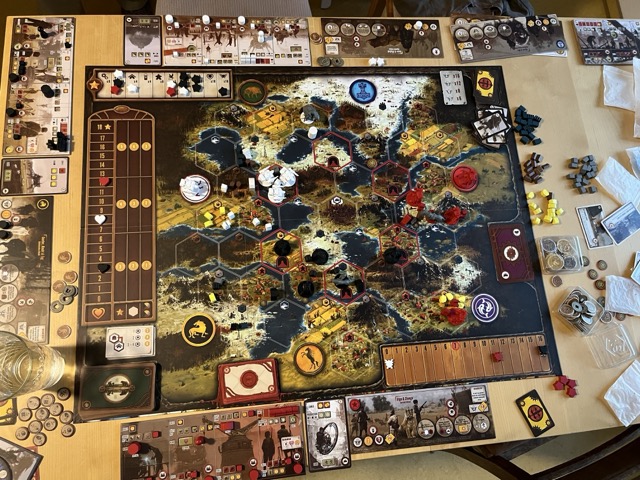
It’s instantly apparent that Scythe has a high degree of complexity. That’s to be expected: it’s a strategy game. Players have to balance different kinds of resources - money, materials, work, base and extended fighting power, and reputation - to achieve several goals. Ultimately, the player who first fulfils six goals ends the game, but without necessarily also winning it: the ensuing final evaluation takes multiple factors into account that contribute to each player’s score.
At first, each player controls a small amount of territory and has no mechs at their disposal. Four of those can be built - once the necessary resources are available. These can be obtained by establishing new settlements in territory that yields resources when the player does a production activity. Initially, players are also unable to cross water bodies (rivers and lakes). For that to be possible, a player needs to build a certain type of mech that enables wading through rivers or submerging in and crossing lakes. Players can also build tunnels, which enable them to move about the board more swiftly.
When one player’s mechs and/or leaders encounter another’s, a fight will ensue (of course). The fighting mechanics have an interesting twist in that the visible fighting power is amplified by (invisible) add-on fighting power. This makes for interesting surprises. The likelihood of such encounters increases very swiftly with the number of participating players.
One nice twist is that players cannot perform the same moves in two subsequent rounds, necessitating some careful planning ahead. This brings me to the conclusion: Scythe is a nicely strategic game with a high fun factor. The strategic aspect is way less hefty than in, say, Terra Mystica, which makes Scythe much more accessible than the former. The competitive aspect is strong in Scythe, but does not dominate: players don’t spend all the time fighting; the emphasis is more on balancing resources and one’s approach.
Warmly recommended.
Tags: games
Castles of Tuscany
At one game night with my board game buddies, we played a round of The Castles of Tuscany. Sorry, no pictures this time.
The game’s concept is simple: you’re running a principality, and have to build castles and cities, roads and fields, mine for marble, and so forth. By doing so, you accumulate wealth, which means you can win against the other players. So far so good - and note that there is no warfare in this game, no attacking of other players. In fact, the only cause for conflict can be the competition over resources. (I have to say I appreciate that.)
Players can unlock several kinds of bonuses (up to four) by building cities, e.g., the capacity to have more workers, or keep more resources in stock. Each of these have a considerable impact on a player’s strategic abilities, so the player should plan ahead which bonuses they want to unlock. There are also bonus points for many different things, such as being the first player to have built three castles, or making all the fields arable.
The game mechanics are an interesting mix of deck building (bonus capabilities) and worker placement (applying abilities and resources). What makes the game very fluent is that it’s practically impossible to be played into a corner. There is always something one can do. Also, because the individual moves are short, consisting of just one action, the pace is swift.
I’ve mentioned the lack of inter-player conflict. Indeed, players compete for resources only, and a little bit for achievement bonus points, which deplete. Other than that, there’s no real conflict: no fighting, no stealing. This lack of interactions between players can lead to a certain dullness. As a lover of cooperative games, I don’t mind it that much.
Overall, it’s a very nice game with a good flow, and can be learned quickly. Warm recommendation.
Tags: games
Marvel Dice Throne
Marvel Dice Throne is a game involving rolling dice a lot (one might guess that given the name), and it has a nice deck / character building aspect, too.
Each player picks one of eight Marvel characters. For each character, there’s a whole collection of character board, individual cards, status tokens, and dice. That means the game’s box is sizeable.
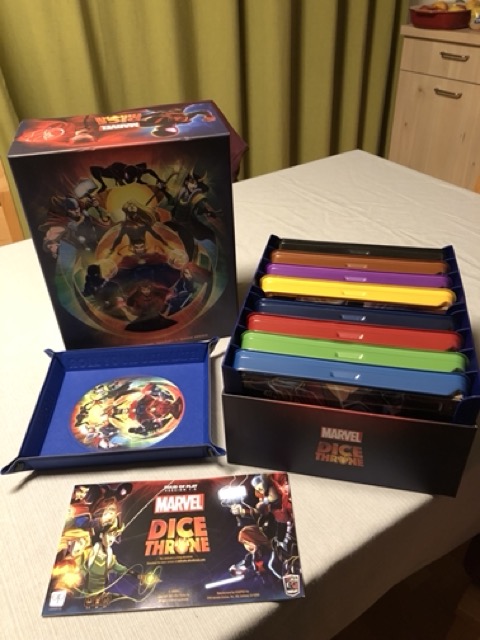
The point of the game is to let up to four characters engage in a battle wherein they, bluntly spoken, smack one another around the place by applying various super powers. For my test, I chose to let Captain Marvel play against Black Panther - for no particular reason.
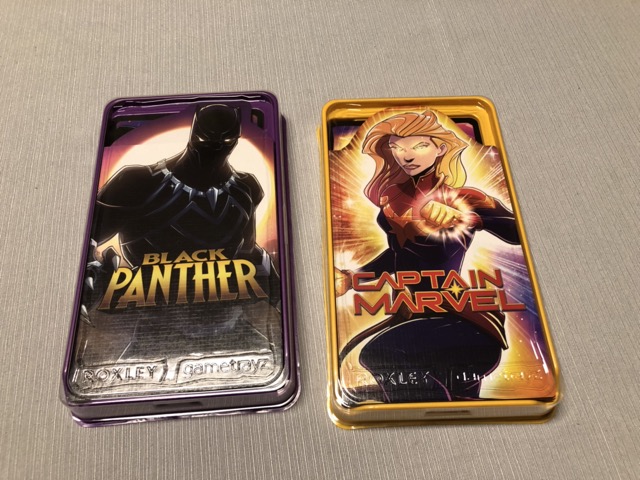
Each of the character boxes contains, as mentioned, a selection of items and cards. These are all set out to prepare the game. In the image below, you can see the setup at the start of the game. The characters start out at full health (indicated by the oblong counter to the upper left of the character tableau). They also have a certain amount of combat points (CP, indicated by the round counter). Each character also has a starting set of four cards.
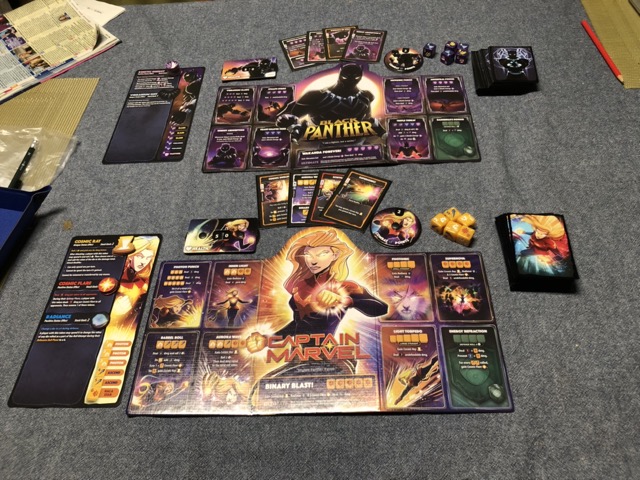
The rules are learned quickly: in each round, the acting character first does some deck building by selling and playing cards (CP are the currency). Next, the character attacks an opponent, who can deflect (some of) the damage by activating defensive skills. This is followed by another round of deck building to wind things down. Each character has special abilities, which are depicted by special cardboard tokens. These add a lot of spice to the game, and make for some surprises.
So far, so good - it’s plain and simple. The game is fast-paced and quite a lot of fun, because the combinations of cards and special abilities, together with the random element added by the many many dice rolls, make for many variations. I can wholeheartedly recommend it.
Captain Marvel won this round, by the way. Narrowly.
Tags: games
Oceans
How about an ultra-maritime board game for a change? And about going back in time some billions of years? How about playing evolution in Earth’s early Oceans.
The first impression one gets of the game is that the artwork is simply stunning. The box gives it away, and it continues like that. (Yes, I have the German version.)
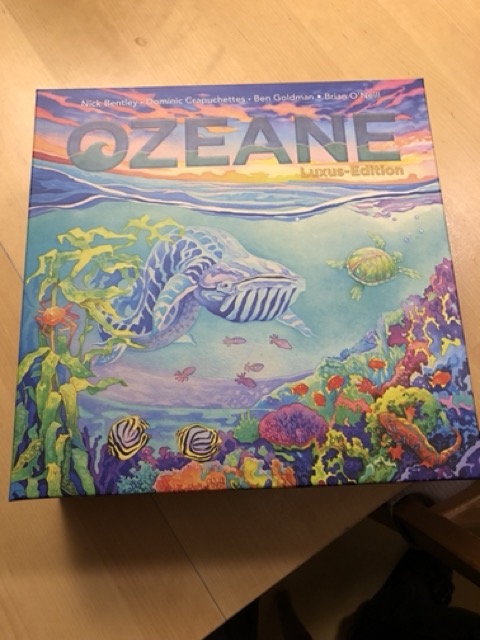
The game is an evolution simulation. Each player is in charge of one or more species that, to put it mildly, compete for evolutionary niches (or domination of the ecosystem) by, to put it slightly less mildly, eating one another all the time. Food and population size are each represented by little colourful cardboard fish that move from deeper levels of the ocean to the reef, where the show is on.
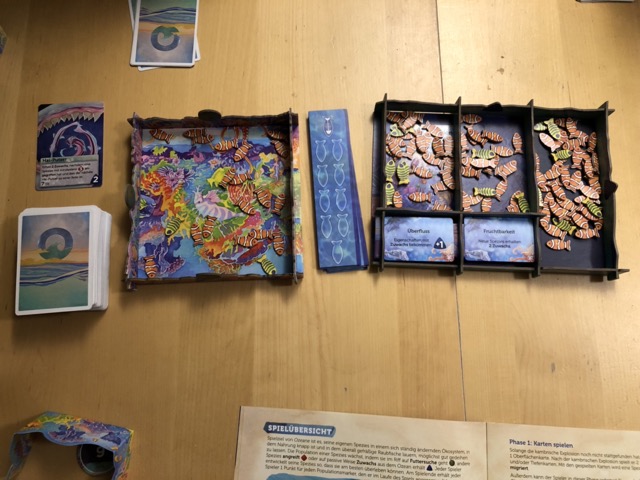
The above image shows the reef to the left, and the three ocean levels on the right. The first two ocean levels have cards that enable new situations in the game as soon as the respective level is emptied. The first ocean level also has a card at the bottom that is unlocked once the level empties, and represents the cambrian explosion, considerably speeding up the game and changing the dynamics once unlocked.
The image furthermore shows, to the far left, a huge stack of cards that represent traits of species. These include, for example, tentacles for more efficient food gathering, special predator capabilities for yet more efficient food gathering, parasitic behaviour for sneaky food gathering, transparency for avoiding to end up as the object of other species' food gathering activities, and so forth. You can see it’s all about food.
In the middle of the image, you can see a stack of oblong paper slips. Each of these represents a species, and the little fish fields, if filled with fish, represent the population size. Once the fishbone field is populated, the species' population is reduced due to overpopulation. (Needless to say, some of the trait cards avoid that.)
Species are assembled from the aforementioned trait cards. Each species can have up to three traits (unless the card unlocks more). These make for rather interesting combinations.
Here’s a photo of an in-game situation. There are three players, each of whom have three species (there is no limit to those, and players can start species whenever they wish). The species are arranged in a circle, with neighbours to the left and the right. Those neighbourhoods, and the proximity to certain other species, play a role. Essentially, this models an ecosystem.
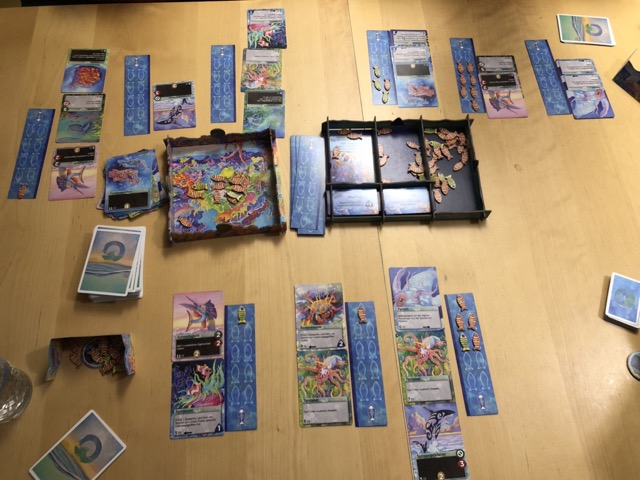
Because of the many interdependencies that naturally occur in an ecosystem, the species can develop a complex dynamic, making the game rather fun to play. Upon every move, some actions will be triggered that may trigger yet more actions. A species is attacked by a predator? Nice, the nearest scavenger species gets their share. Ooh, even better, their neighbouring species also gets something because they’re parasites. And so on.
Here are two species that ... evolved during this game. (Behold the artwork!)
First, meet the greedy parasite whale neighbour nobody likes. This species will always scrounge population from both its neighbouring species, putting both of these in perpetual danger of going extinct, and it can’t suffer from overpopulation.
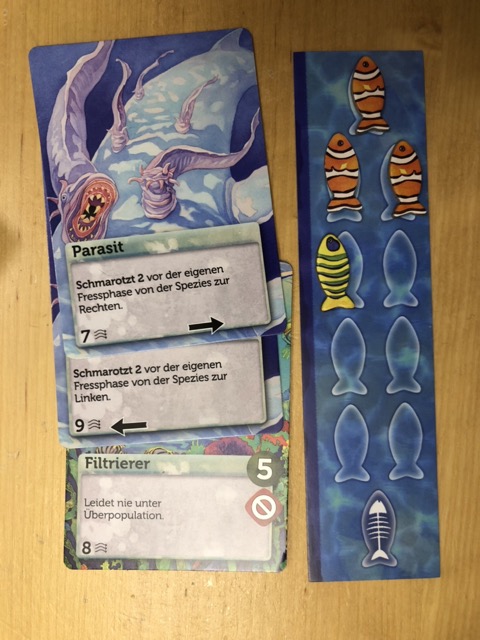
And here's the biggest jerk in the ocean: a parasitic tentacle-ridden super predator. Get out of its way or be eaten. Or be eaten anyway.
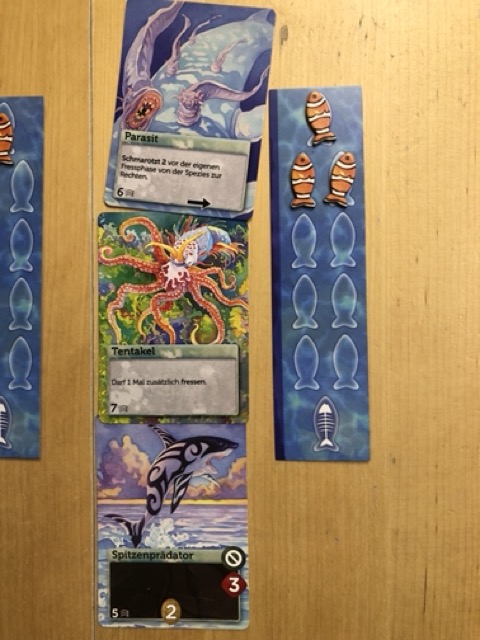
I haven’t explained much about the gameplay - it’s a simple round-based scheme: play cards, have your species do their thing (i.e., eat), let them age (i.e., remove some population), replace cards in your hand. Playing a card represents a step in evolution: a species develops a new trait. After the cambrian explosion, everyone gets to play two cards instead of one, speeding up evolution, and aging doubles as well, speeding up extinction.
The fun is in spawning and fostering species, and in sometimes letting go of some of them in a controlled way (unless when they’re eaten out of existence). It pays off to be a bit strategic by paying attention to where the whales and predators are (certain kinds of scavengers can use them). It’s also important to note that all species of all players interact.
Once you start playing with the “deep sea” cards (not shown here), things get really interesting: each of these 120 cards is unique, and many enable the nastiest jerk moves.
This game is wonderful. It’s so much fun to build the ecosystem “machine” and see its dynamics unfold. Really warm recommendation for anyone who likes engine builder games.
Tags: games
Dorfromantik
When the game Dorfromantik was first released on Steam, it instantly got popular. Maybe because it’s different: the player doesn’t do much besides assembling landscapes from hexagonal tiles. There are missions and tasks, yes, but there’s no real conflict - the game is peaceful, and the artwork is really nice.
I had never played this on Steam; my son had shown it to me and explained it. I liked it enough to keep it in mind. When I read about a board game edition of Dorfromantik, I was instantly interested and got a copy for the family. Yes, the family: other than the Steam game, the board game can be played not only solo, but by up to six players. It’s still conflict free by virtue of being cooperative.
The game is played by picking random task tiles (there have to be three active tasks on the board) and landscape tiles. They are assembled by following some simple rules: rivers must connect to rivers, and railways to railways. Anything else connects however the player wishes. The idea is to form combinations of tiles that yield areas of forest, corn fields, village, or stretches of railways or rivers large or long enough to satisfy the task.
One begins by picking three tasks (the sizes are also random). See below for a start, and also for the situation a few moves in.
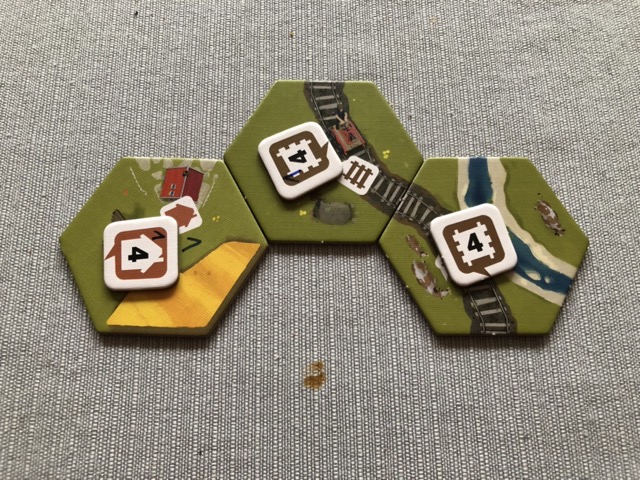
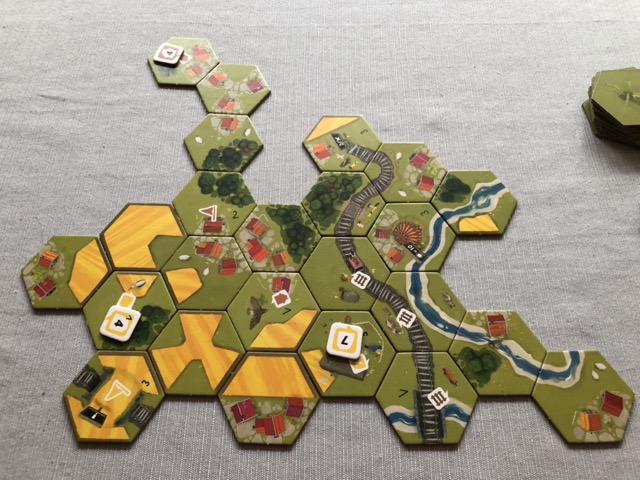
This goes on, until eventually there are no more landscape tiles left. The more tasks one got to complete, the better - there are points to be collected. See below for the final state and the evaluation sheet. I didn’t do too well - played myself into a corner here and there, and made some stupid mistakes. However, because I made 30 points in this game only from railway tasks, I unlocked an achievement. Thanks to this, I get a new tile I can use in future games.
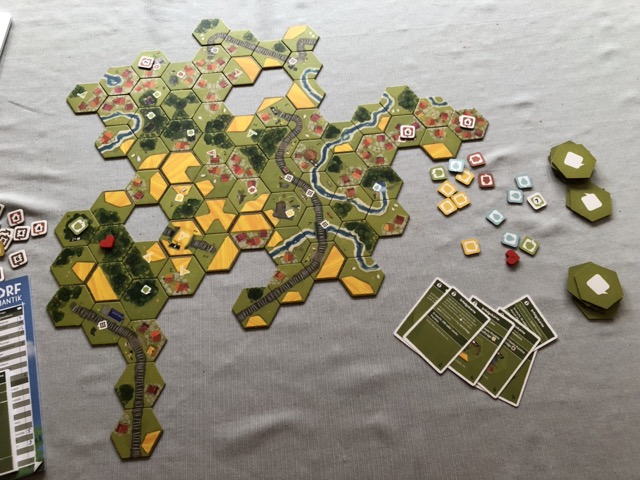
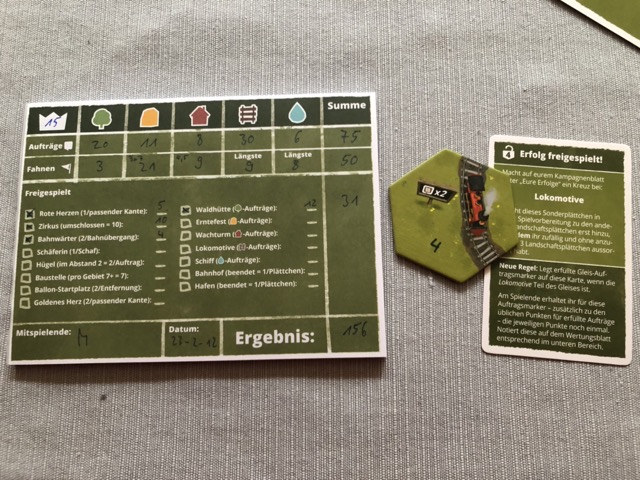
The achievement model is nicely done. There are several cardboard boxes that stay closed at first, but can be opened by making achievements. These accumulate in a campaign, progress of which is tracked on another sheet that contains more unlockable achievements, all of which also enrich the game.
Dorfromantik is beautiful, peaceful, cooperative, and had all four of us in the family hooked instantly. It has a strong long-term engagement force. I very warmly recommend it.
Tags: games
Robinson Crusoe: Adventures on the Cursed Island
My friends and I recently played a round of Robinson Crusoe: Adventures on the Cursed Island.
This is a cooperative game. Up to four players each play one character, and the group loses as soon as one of the characters dies. Unfortunately, the game makes it very easy for that to happen. But let’s see.
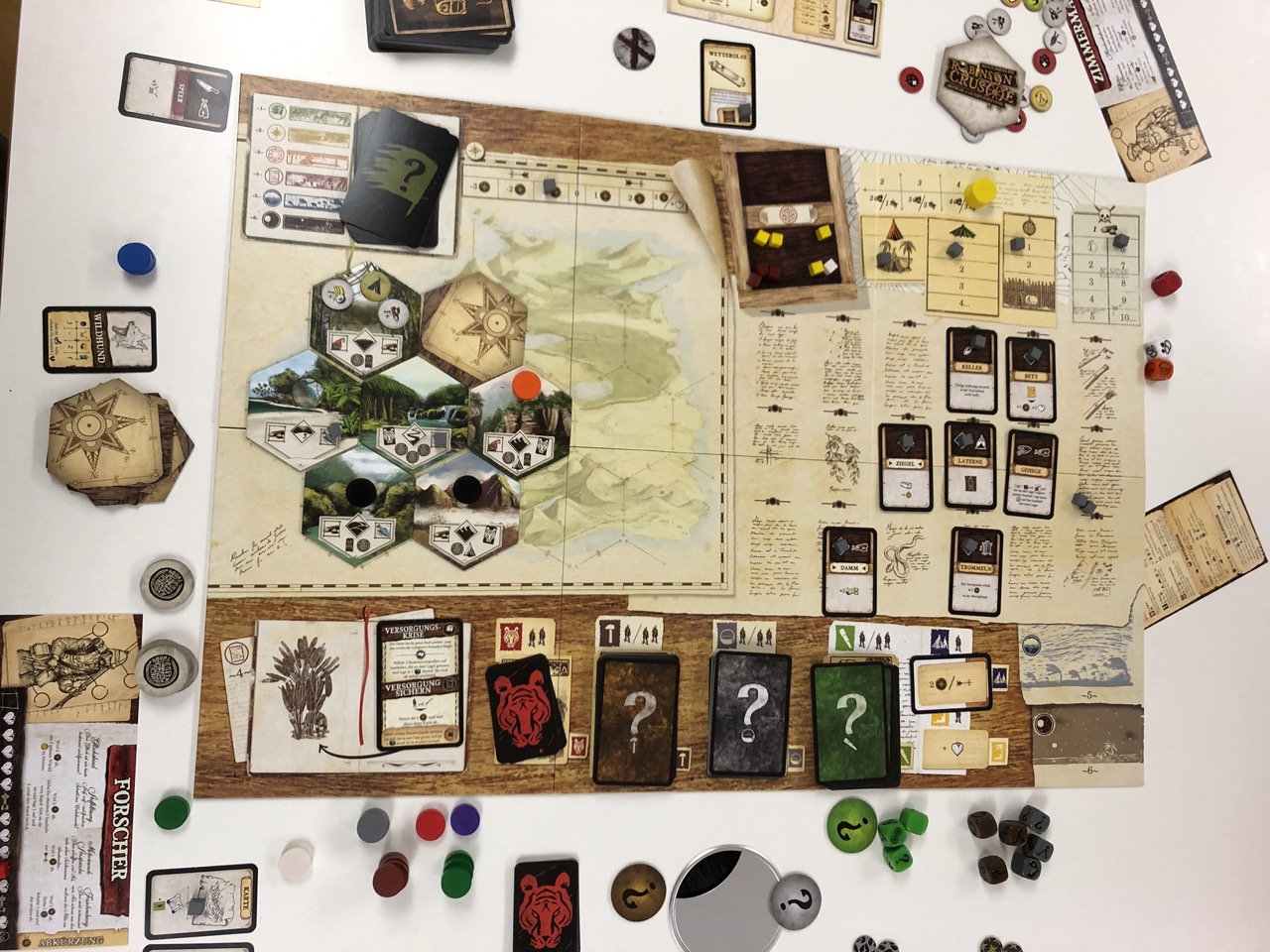
The image above shows the board, after we’d been playing for a while. The island has been explored to a degree. The different types of terrain yield different kinds of resources (food, wood, game, etc.). To the right of the map, the cards represent tools we can build. The cards at the bottom of the board represent animals we can hunt, and different (usually bad) events that can happen when we build, harvest, or explore. The cards on the top left are events (also usually bad) that occur every round. To the top right of the map, there’s our supply (food, certain materials), and to the right of that, some fields representing the state of our shelter and fighting strength.
We played one of the supposedly easier scenarios, where we have to light a pyre to attract ships for our rescue. This involves piling up wood and developing the ability to light and control fire.
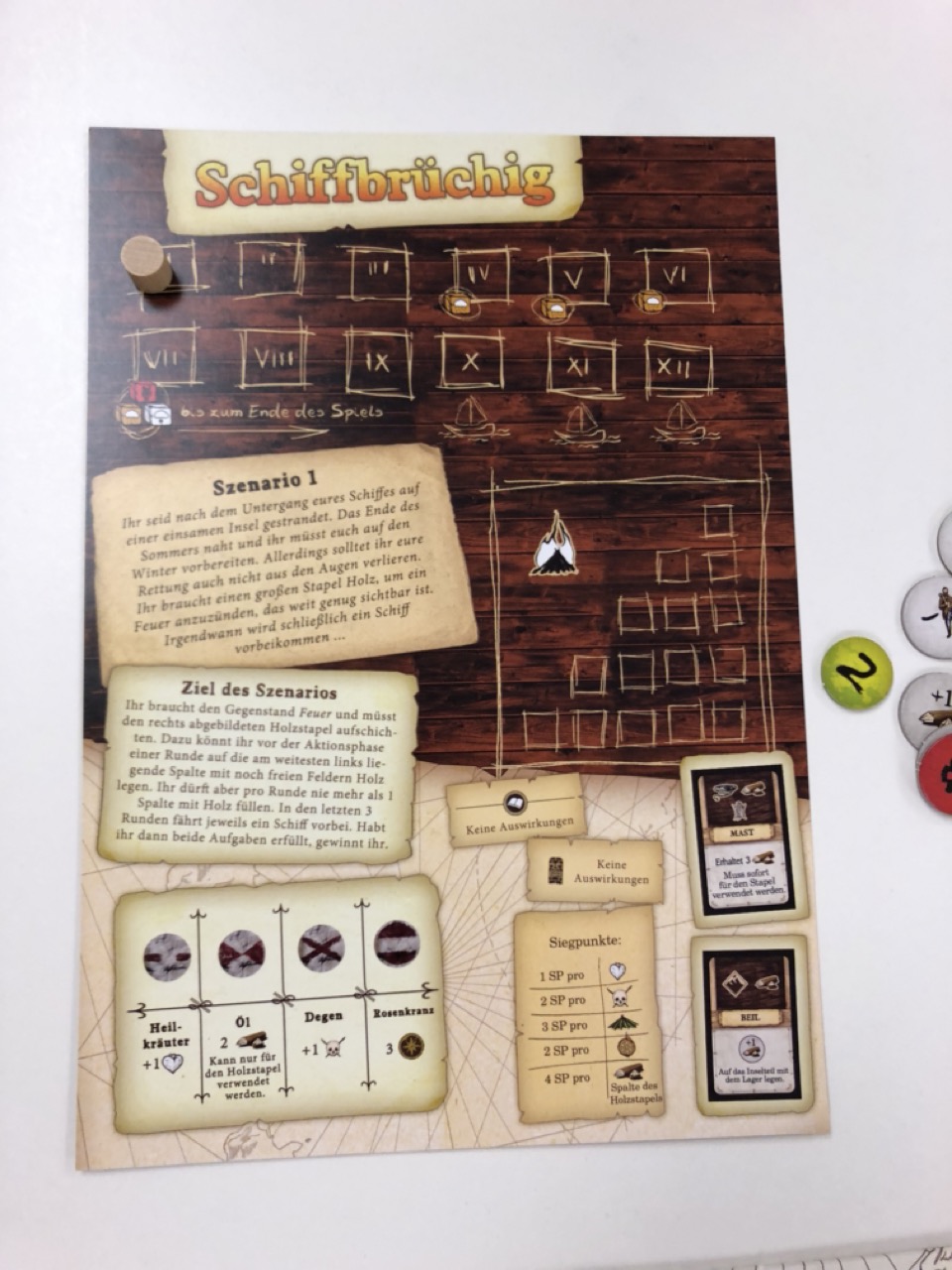
The scenario takes 12 rounds. During the first few, things are fine, but then the weather sets in during rounds 4-6, and it gets worse starting in round 7. The job, now, is to build a shelter (lest the weather affect our health), collect food (lest we starve), and fend off all kinds of inconvenience (lest our morale drop, which has amplifying negative effects on just about everything else).
You get the idea: the game doesn’t make it easy to win. I’ve mentioned morale: this is a really important resource. As long as morale is high, all kinds of special abilities of the characters are usable. The trouble is, a single night spent famishing can make morale drop considerably, and then everything gets very complicated. Special abilities get lost, the effects of hunger and wounds amplify, and a downward spiral sets in.
Needless to say, we lost. Our quick retrospective analysis led to the insight that we had invested too much in the mission goal (by piling up wood) too early, instead of first creating a foundation that allowed us to sustain our sheer existence (by ensuring stable food supply and a roof above the head to shield us from the weather).
This game is hard, very hard. One could be tempted to believe it’s intentionally biased towards being impossible to win. I don’t believe that’s the case: it’s just a game that makes one think really hard about what to do next and how to use the available resources wisely. Every step can be the final one.
I recommend this game for people with a lot of frustration tolerance (or the strong will to build some). In that case, it’s a really engaging game with lots of interesting challenges and lessons to learn. If you want to just have a good time, consider slashing some monsters in another game, and stay away from this one: it’s really serious.
Tags: games
Dune: Imperium
On a past monthly game night, some dear friends of mine and I played Dune: Imperium. This is a very interesting combination of Dominion style deck building and strategic worker placement.
Each player represents some faction from the Dune universe. While the start decks are identical across factions, each faction has a special ability that is activated by one of the cards in the deck, and some start with extra resources or other advantages.
Players initially have two agents whom they place in activities - harvesting spice, rallying troops, building reputation with parties, engaging in galactic politics - to gain resources, e.g., money, spice, troops, intrigue abilities, more agents (temporary or permanent) or reputation. Each of these can be used in various ways to gain points. Whichever player first reaches 10 points triggers the endgame: a final round to close off the game.
The variety of resources mentioned above should hint at the complexity of the game mechanics. Indeed, it’s not easy: there are many different effects to take into account, and a player needs to carefully think ahead to avoid finding themselves stuck in an unfortunate position.
Three of us had never played the game before, but we all got into it quickly in spite of the complexity - a solid reminder that “complex” is not the same as “complicated”. We were playing the German translation of the game and ended up in a hefty dispute about how one of the intrigue cards was to be interpreted. We could resolve this only by looking at the English original of the card, and the conclusion is that the translation of this one really isn’t good. Ah, board game woes.
As mentioned, the game is a combination of deck building and worker placement. It comes with a nice degree of complexity that aptly mirrors the intricate political situation seen in the Dune universe. We really enjoyed playing it. I highly recommend it to anyone interested in this kind of game.
Tags: games
Tainted Grail: The Fall of Avalon
Tainted Grail: The Fall of Avalon is a board game set in post-Arthurian times. The land is being seized back by old magic, it’s a dark age. The heroes of the village are out on a quest that no one knows the prospect of, and the substitutes are lined up to secure the settlement. Yup, that’s right, the substitutes. These are the characters controlled by the players in this game.
The box is big and full of cards, alongside rulebooks and one rather sizeable “book of discoveries”. There are also numerous tokens and several figurines.
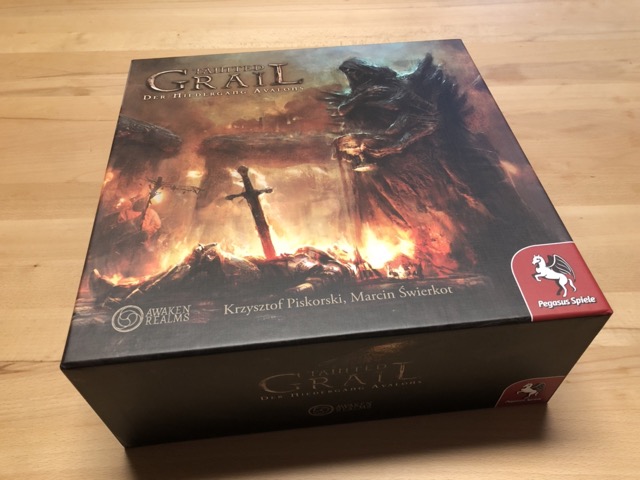
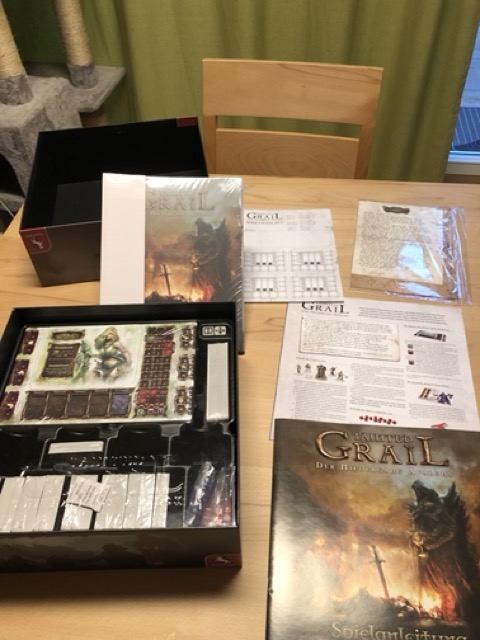
Thankfully, Tainted Grail comes with a solo-player tutorial scenario. It’s largely scripted and allows for only very little variation, but that’s the point: at the same time, it’s highly instructive and introduces most of the relevant aspects of the complex (albeit not complicated) web of mechanisms.
The tutorial first walks a newcomer through the entire setup, building up to a layout like the one in the following picture.
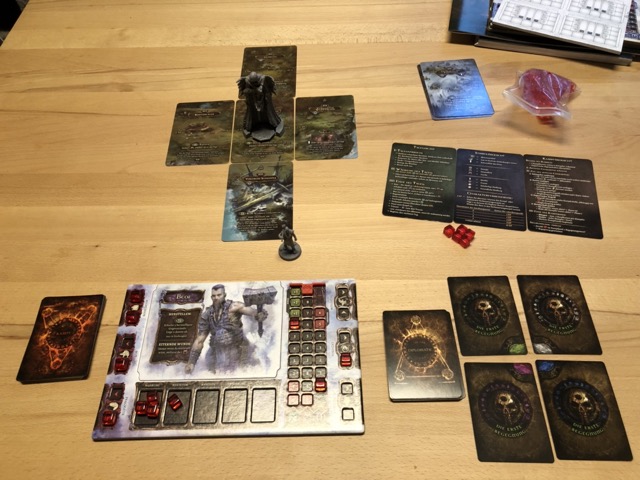
The terrain is represented by cards. New cards can be discovered by travelling - but only within the boundaries of a so-called menhir’s reach. The menhir is the large figurine at the center of the cross-shaped terrain in the picture above. Menhirs are sources of good magic that prevent people from going mad, and in later stages of the game, it becomes an important routine to “recharge” them.
Heroes - the tableau of the tutorial character is shown at the bottom - have the usual features: energy, health, and fear (which, as it adds up, develops into madness), and some character traits that control the heroes' abilities and reactions during fight and diplomacy.
That’s right: diplomacy. In addition to the usual smack-em-on-the-head type of encounters known from many role-play games, encounters in this game can also involve convincing suspicious folk of one’s integrity. The mechanics for fighting and diplomacy are the same, but the skills used are different, and different characteristics are at stake.
These mechanics are rather well done; the fight and diplomacy decks each have cards that can be applied and combined according to certain rules. Sometimes, magic unlocks another card; sometimes, it’s sheer aggression, or cunning.
The tutorial took me about an hour to play, and certainly interests me in continuing. The atmosphere of the game is thoroughly sombre, there is rarely anything joyful, things are mostly grim. While that may not be to everyone’s liking, I enjoyed the well designed mechanics and great artwork.
Tags: games
Mini Rogue
I’ve had a chance to test another tabletop game: Mini Rogue!
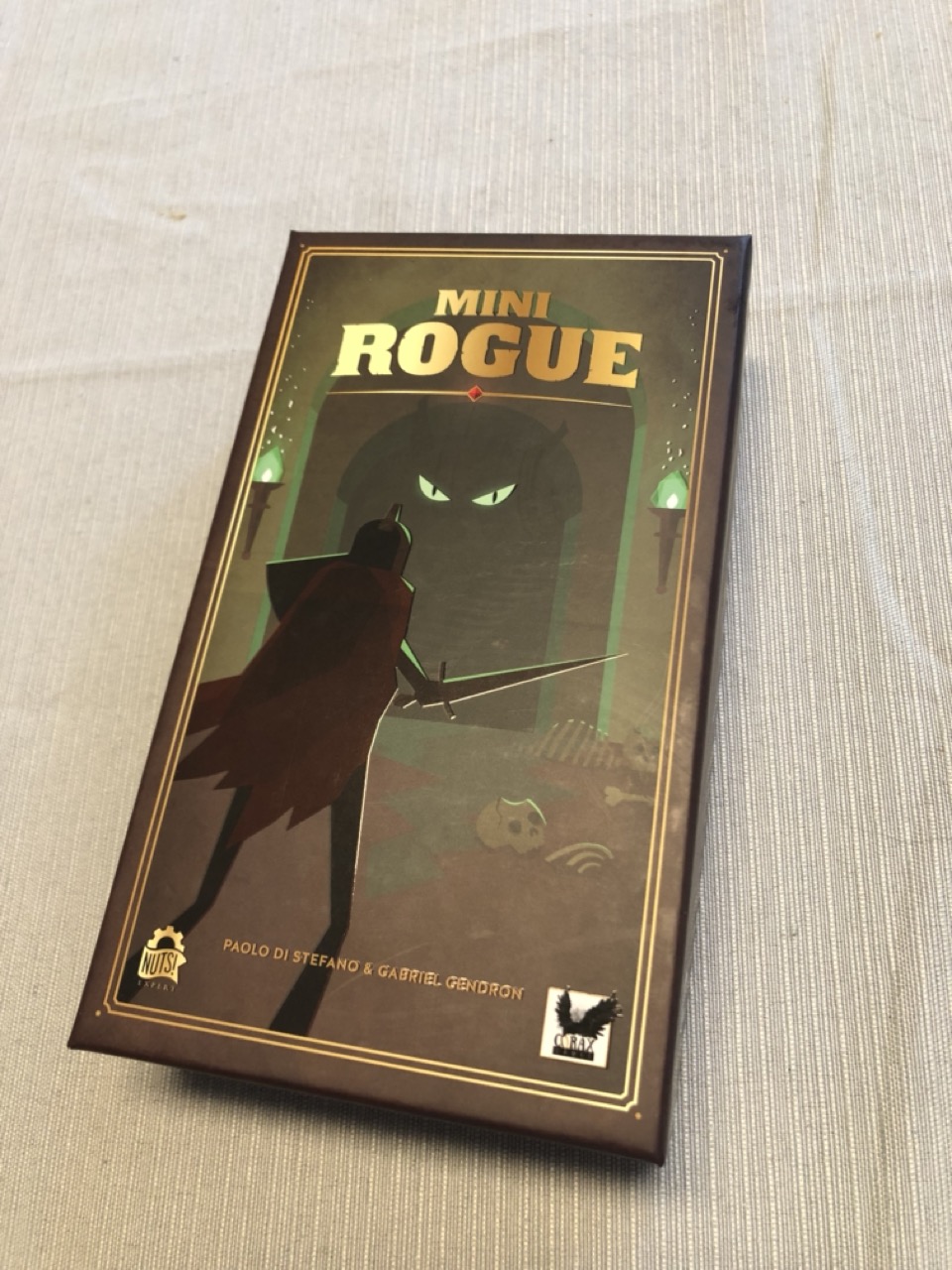
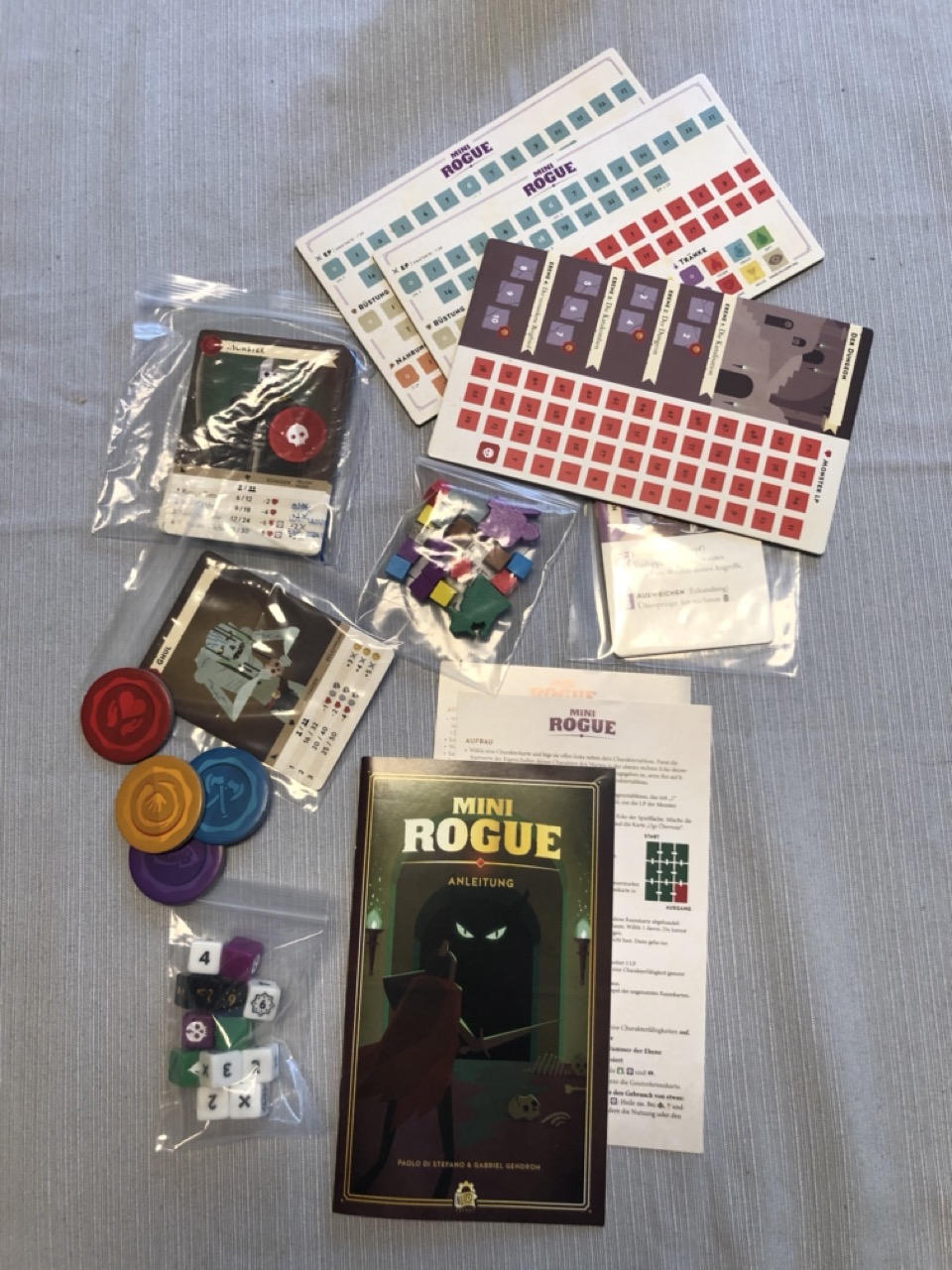
Mini Rogue is a classic dungeon crawler, and it’s solo playable. Optionally, a second player can join for a cooperative mode.
Here’s the single-player setup. Everything about the player’s character is at the bottom: character card (there are several, with different capabilities), character data (experience and life, armour and gold, food and potions), and rewards. The character starts at level 1, with one (white) character die and the (black) dungeon die, which is used to control all kinds of events.
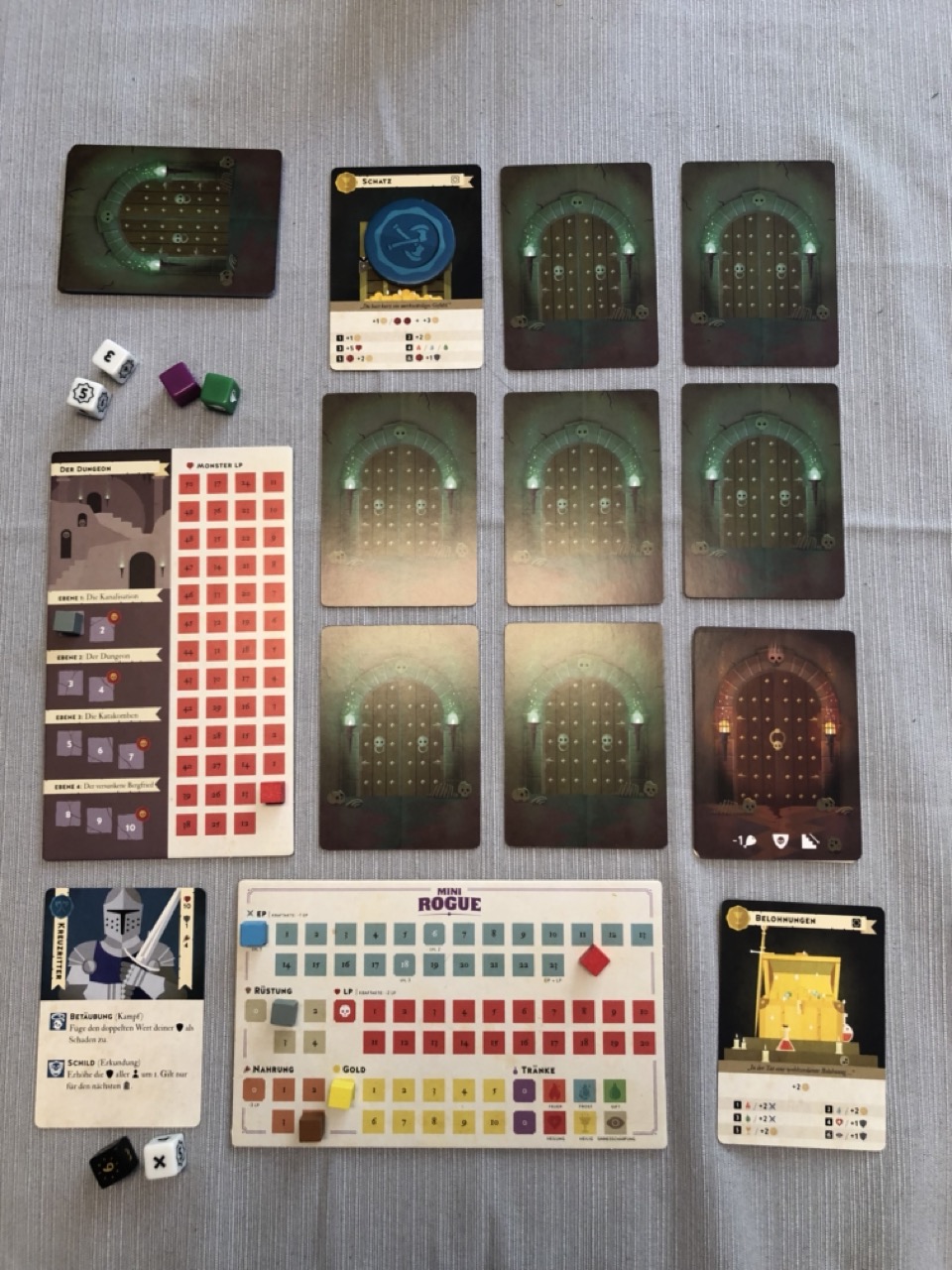
The dungeon is organised into four levels (see the card on the left), each of which has a boss monster to fight at the end. The current part of the dungeon is laid out as a 3x3 grid of room cards. The player enters the part of the dungeon at the top left, and proceeds right-and-down to the bottom right, where there are exits or bosses.
Each room is first “handled” - this involves the typical dungeon crawler activities: finding treasures, fighting monsters, falling into traps - before the two adjacent room cards are unveiled and the player can pick which room to explore next. The cards use a clear yet complex-at-first visual language to concisely describe the effects and benefits of events.
Of course, in my first game, I was utterly defeated by some kind of worm (see how the red life points marker is at zero):
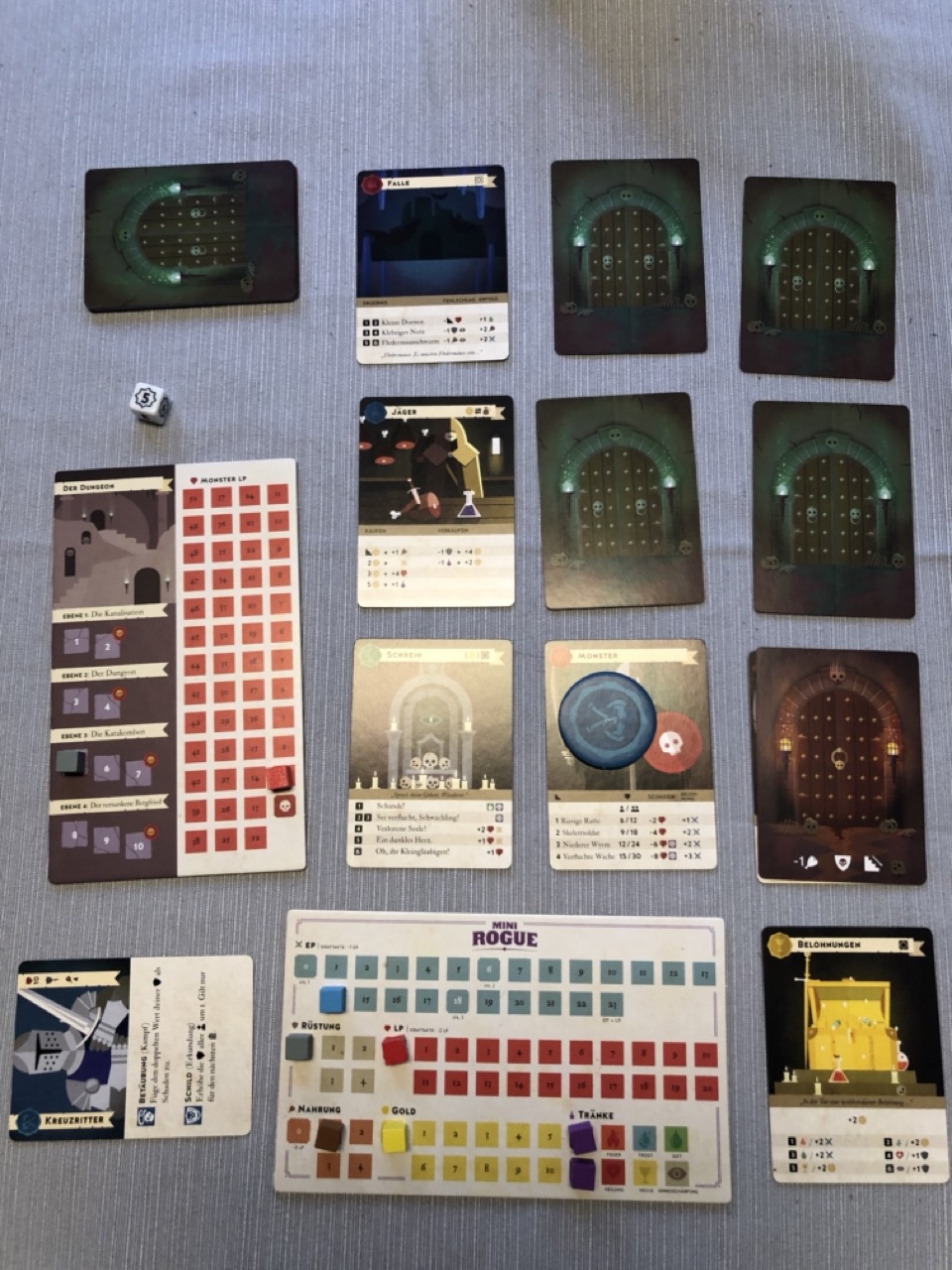
Still, I thought this was fun, so I continued to play. It took me five or six attempts, but eventually I triumphed:
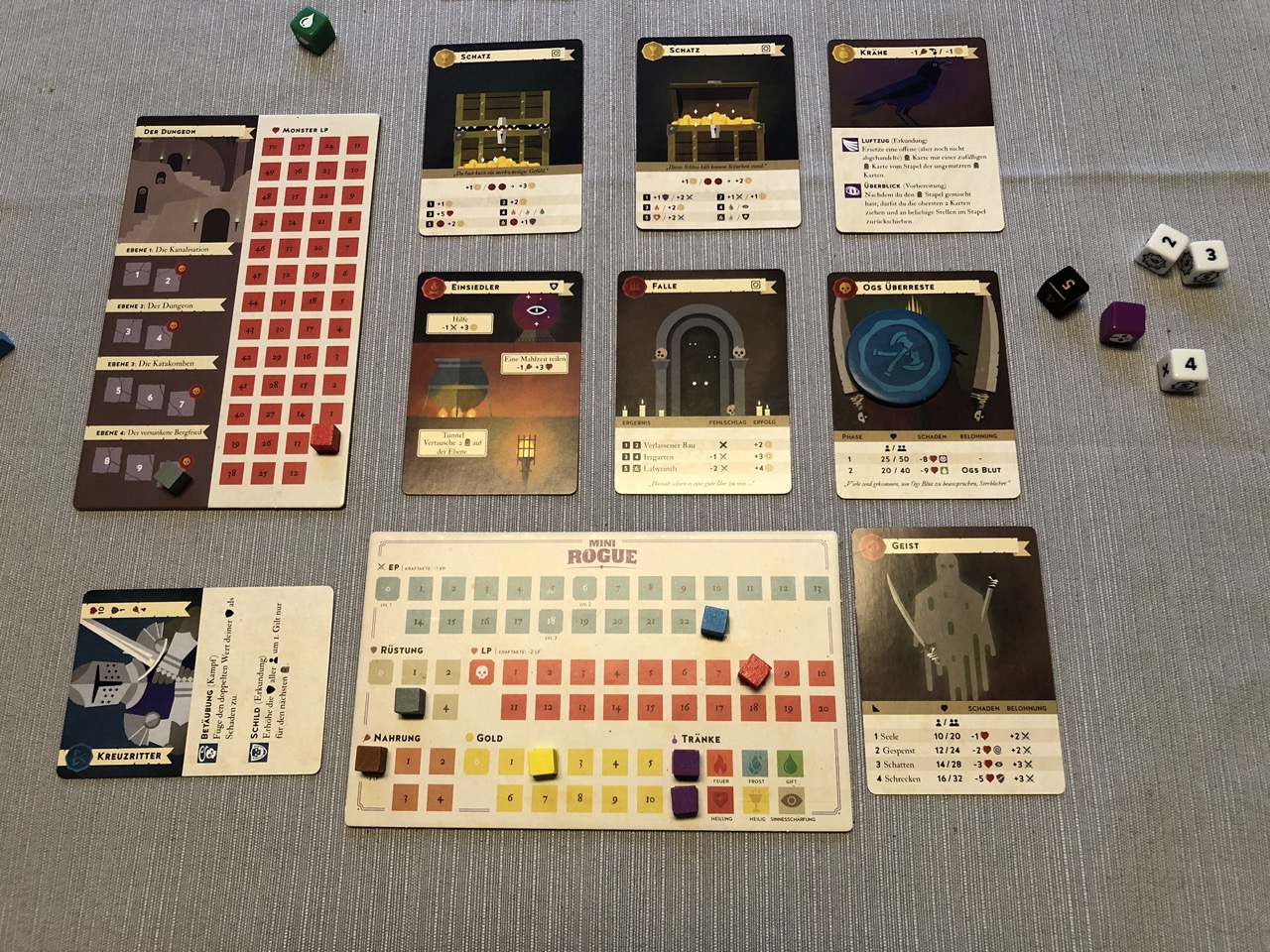
Note how there are suddenly three white dice: this means my character advanced to level 3. There’s also a purple die: this means the character got cursed. If the curse die shows a skull (this will happen in 50 % of rolls), all character dice have one point removed from them. The green die (visible here at the top left) is for when the character is poisoned. Happily, that wasn’t the case here.
I loved playing Mini Rogue. It’s fast-paced and fun. The somewhat complex mechanics and many different aspects made it necessary to read things up in the manual a lot, but that got better over time. I believe that once I’ll have understood and memorised the rules, it’ll be a breeze.
The game isn’t easy to win. It takes some amount of careful planning, tactics, and strategy. However, the game is biased towards luck: the best tactics will fail if the dice and cards don’t agree. This bias is a bit too strong in my taste, but maybe that’s just me being inexperienced. I’ll definitely give it more chances. Also because I want to try two-player mode soon. Warm recommendation.
Tags: games
A Minecraft Board Game
Knowing I love Minecraft, friends gave me the Minecraft: Builders and Biomes board game for a past birthday. The family and I gave it a try. Unfortunately, I forgot to take pictures. The review I linked to has some.
Basically, the game is about - you guessed it - mining resources, building, and knocking over hostile mobs.
I’ll start with the end. Your choices for what buildings to build (and where to place them) as well as what monsters to fight have considerable impact on how many experience points you score (the player with the highest score wins). The built contraptions are evaluated thrice: in the first round, larger biomes get you more points; in the second, larger groups of buildings crafted from the same material; and in the third, larger groups of buildings with similar purpose. As you can place buildings atop one another, some planning ahead is advisable. Similarly, some monsters enable you to make additional moves once slain, but others get you additional points in the end, so here too, it’s important to pick your enemies wisely.
Mining is done in a particularly nice way. Each resource item is a wooden cube. 64 of those are stacked into a 4x4x4 cube that players can take apart when they mine. Mining away the first, second, and third layer of the cube will trigger one of the scoring rounds, and the third will also end the game.
Cards with buildings to build and monsters to fight, and weapons to pick up for the preceding purpose, are all laid out in a 4x4 grid of 4-card piles. In addition, 4 weapon chests are placed on each side of the grid. All cards are initially placed face down, and are revealed as players walk around exploring the grid.
You fight monsters by drawing, at random, three cards from your weapons pile. Each player’s default deck has three poisoned potatoes serving as blanks that you can toss at monsters, but they’ll just bounce off and cause no damage. Collecting some diamond swords and TNT from the weapon chests is recommended.
The gameplay is fast, fun, and the rules are simple. Yet, the strategic aspects of the building and monster slaying make it more interesting than it may sound at first. The graphic design of the cards is great; especially the building cards are very detailed and beautiful.
Overall, this is a nice adaption of the computer game, and many of the original’s aspects have been brought into the board game setting in a way that makes sense. The game has a nice mix of strategy and luck, and the materials are nice and well crafted. Fun. Warm recommendation.
Tags: games
Aeon's End
Here's a short review of Aeon's End.
If you like Dominion, and would like to play something similar in a cooperative fashion, Aeon's end is just what you want. It's got deck building, with some cards representing currency; and others, artefacts, energy, and magic spells. Yes, magic: each player represents a wizard, and the wizards fight a boss monster and its minions together.
The magic system is well done: spells must be planned ahead one move, and there are limited resources for activating them. Each wizard also has a special skill that can be activated once the wizard has accumulated enough energy, which can be purchased.
There's a large choice of wizard characters to choose from, and it can be an interesting exercise to round up a good army of them and supply of cards that can make for an interesting game. (Like in Dominion, there's a limited number of kinds of cards that can be part of the game to begin with.)
Boss monsters come in many shapes, sizes, and difficulties as well, and they spawn minions, sometimes many of them. They also have "plans" which they announce some rounds ahead and which can be flattened by the wizards before they're played out (which can have really, really severe consequences).
I've found Aeon's End to be fairly well balanced, with an interesting gameplay, and surprising dynamics. As mentioned, if you're looking for a cooperative kind of Dominion, this is for you.
Tags: games
Crime City
A while ago, the family played a game that we all found entertaining - Micro Macro: Crime City. The concept is really simple. The players get a large (large!) map with lots and lots of tiny little details, and a dozen or so card decks describing crime cases the players have to solve step by step (card by card).
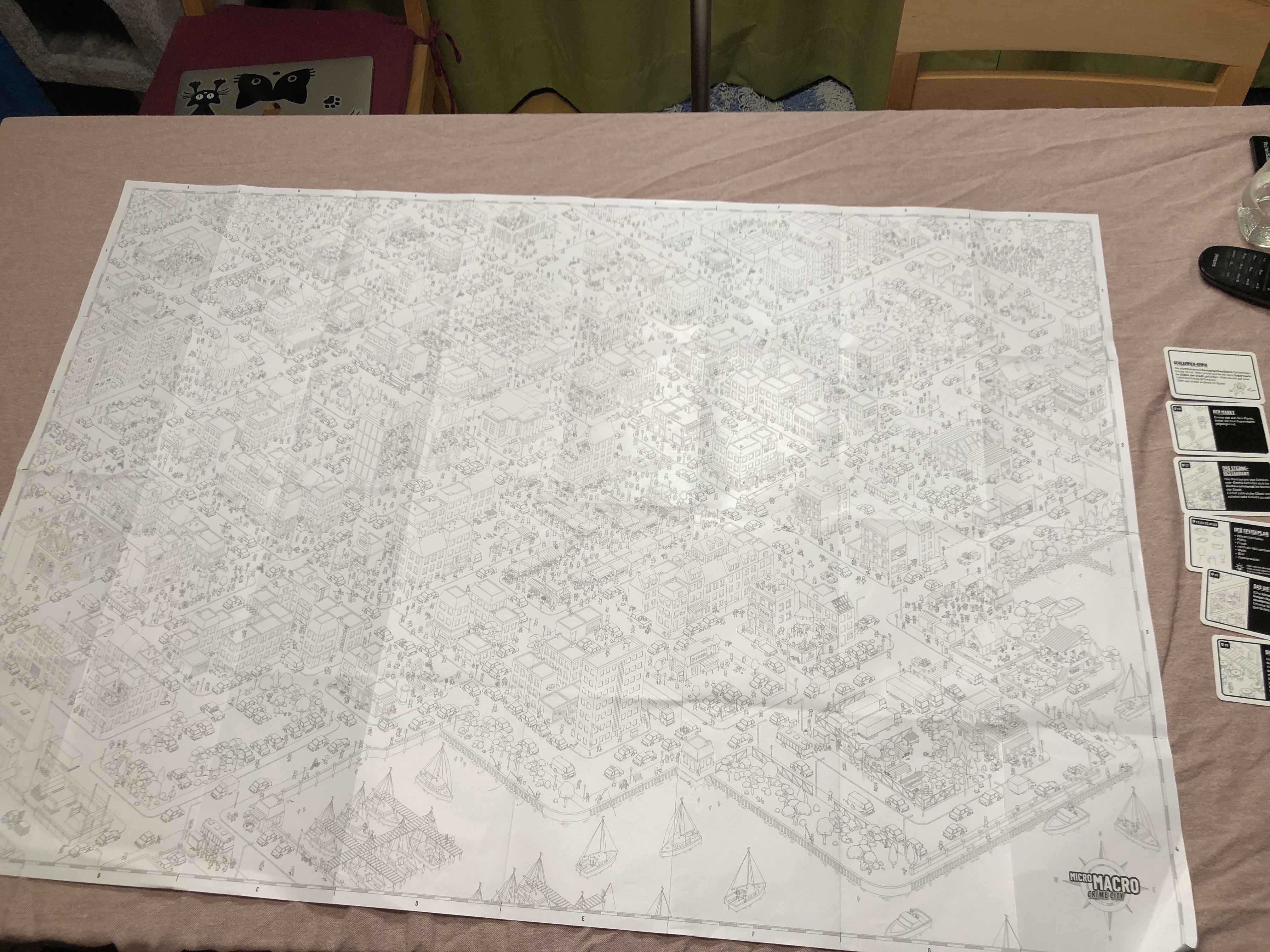
Yup, it's a large and detailed map indeed.
The card deck starts out with the description of a crime scene that the players have to find on the map before they can move on to answering the first question. Once they are confident they've found the answer, they turn the card and read the back side, which gives further hints. Then, it's the next card. Each case deck consists of up to nine or so cards.
As mentioned, the concept is really simple, there are practically no rules to remember. Don't be fooled - solving the cases can be rather tricky, and sometimes require a fair amount of deduction and combination.
The only downside is that once all the cases are solved, the game doesn't have a high replay fun factor any more. I'd still recommend it warmly.
Tags: games
Bad Bones
I'd like to introduce another fun board game: Bad Bones. It's a board game rendition of a classic theme: tower defence.
Up to four players are facing the risk of having their tower and village raided and razed by an army of skeletons, who advance from the nearby woods. Whenever a skeleton reaches a tower or village, it inflicts damage, and as soon as either the village or tower of one player are destroyed, that player loses. Happily (?), those skeletons aren't too smart (how would they, without the brains to think) and move in very predictable ways. Also, they're just bones, so they can easily be smashed by the player's hero, who moves about the field freely.
The players can control how the skeletons move by placing traps. A skeleton hits a wall? It bumps off of it, takes a 90 degree turn, and continues moving in the new direction. A skeleton trips on a catapult? It flies off into the woods. And so forth.
Skeletons hitting walls and being sent off by catapult has consequences for those traps - they need to be repaired or will be permanently damaged after a second encounter with a skeleton. Skeletons moving off in new directions or flying around also has consequences - a skeleton entering the forest again will end up in the neighbouring player's playground, and catapults mean the player can choose which other player a skeleton is going to pester next.
Bad Bones can also be played in cooperative mode, wherein the players have to coordinate wisely to work with a shared pool of traps.
The game has very simple mechanics - which have complex implications. Players need to pay a lot of attention to using their resources, agree to losing some of their towers and village houses, and look ahead a few moves to anticipate skeleton movement. The random element of other players sending their skeletons one's way adds some spice.
It's a lot of fun, highly recommended.
Tags: games
Lunar Base
Card game time! I backed Lunar Base on Kickstarter, and having played several rounds since it arrived a while ago, I'd like to share my impressions.
The box comes with a small extension - some extra cards - for Kickstarter backers. What I particularly like about the box is that it has a magnetic lid that snaps nicely and firmly closes the box. It's not really necessary to do that, but gives a certain sense of quality.


The contents are very well done. The neat and well-written rulebook includes some example moves, and is a quick read. The rules are simple and can be learned in 10-20 minutes by reading the book or having them explained. There are six circular credit markers, and lots of cards.
The cards are used to build a base on the moon. Some of the cards are agents - one-time actions - but the majority is modules from which the base is assembled. The modules connect at the coloured semi-circles on their edges. The colours must match for a connection to be valid. Grey is a wildcard - any colour connects with it. Any complete coloured circle is called an "orb". Playing an agent or building a module can have a cost, which is expressed in orbs. Orbs not found in a player's base can be substituted by spending credits.
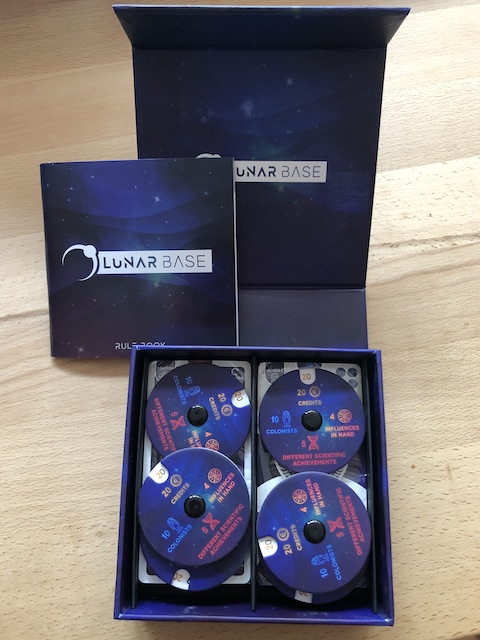
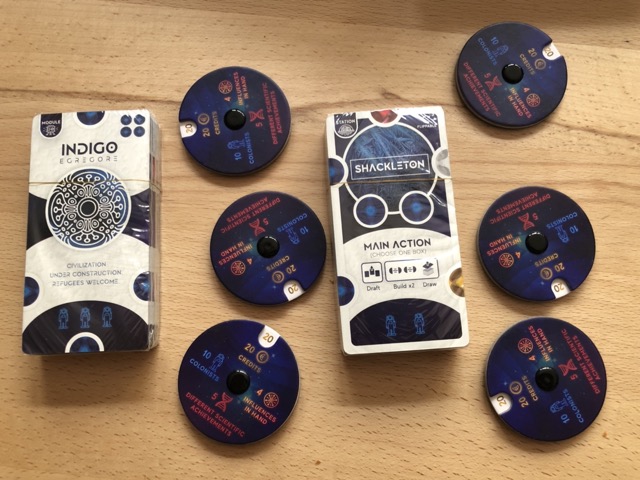
Each player is dealt three cards and a station module (the heart of the player's base). Furthermore, there's a supply of cards that's drawn from the hidden pile. In any move, a player can first play an agent, and then pick one action from any of their modules. Actions include drafting cards from the supply, drawing from the hidden pile, discarding cards, building modules, selling supply parts, and also stealing credits or modules from other players. Some modules, when built, have immediate effects. Thus, the action chosen by a player can spawn sub-actions, so that complex moves are a possibility.
The final part of a player's move is to re-supply - this happens if the supply in the middle of the table is drained. New cards are drawn from the hidden pile, and players earn credits for orbs.
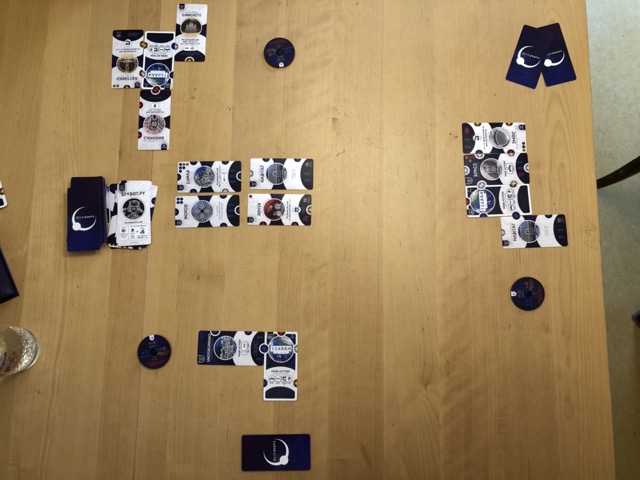
There are four winning conditions: you earn enough credits, you have enough colonists (blue figures on the modules), you have enough different scientific advancements (red symbols), or you have enough influence. (The influence cards aren't shown here, we haven't played with those yet as they add complexity and we want to understand the basics first.)
Here's a winning base: it has both 10 colonists and 5 different scientific advancements, so two winning conditions are met.
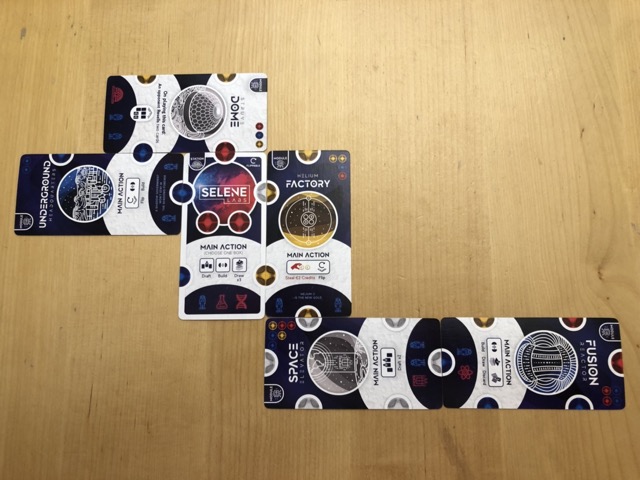
The game is fast-paced and fun (make sure to read the tiny nerdy descriptions on the cards). The fun increases with the number of players. Very warm recommendation!
Tags: games
Under Falling Skies
Do you remember Space Invaders? Did you ever have fun playing it and wished for a less hectic and a tad more strategic experience? Well, here it is, in the form of solo board game Under Falling Skies.
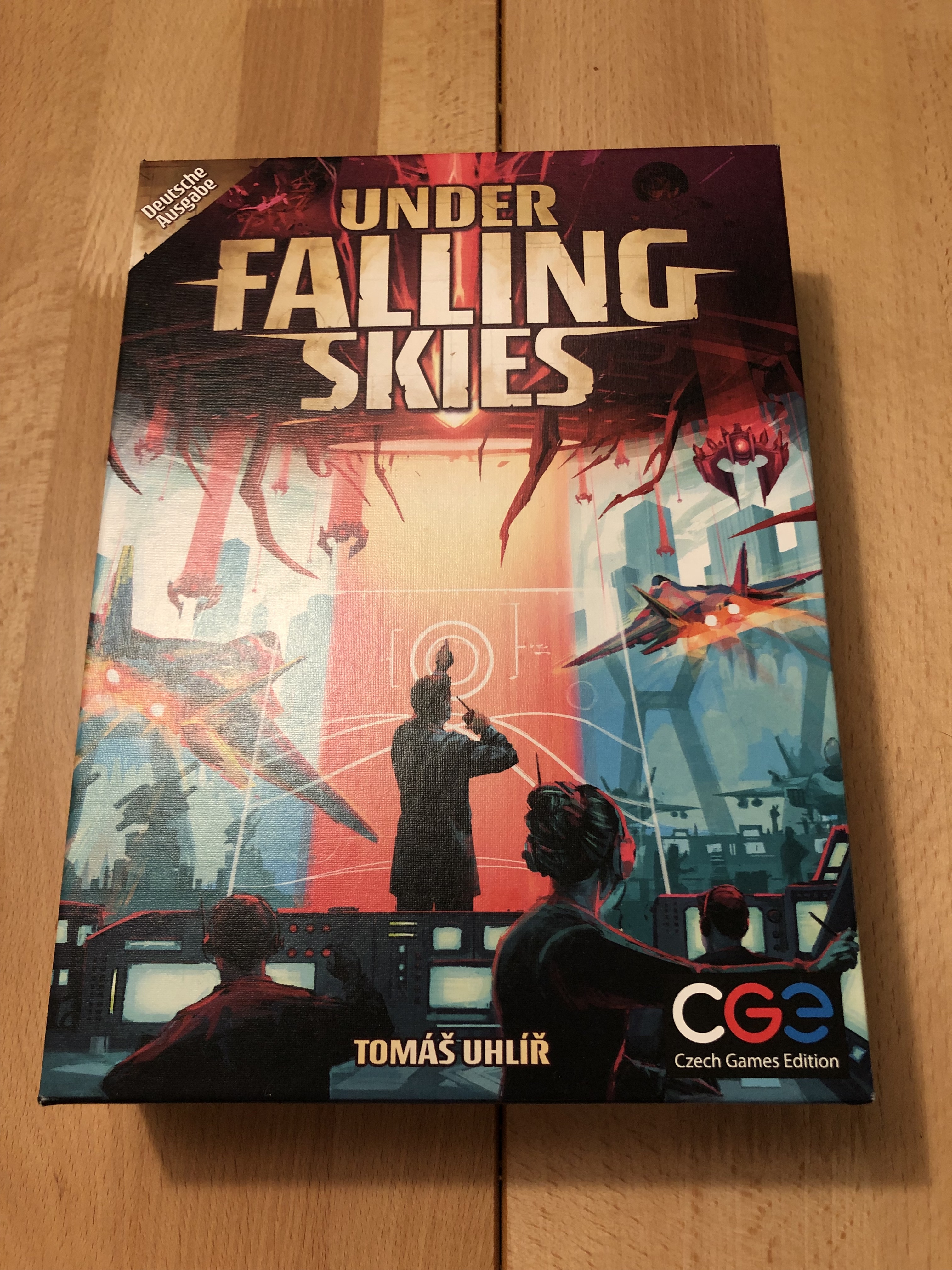
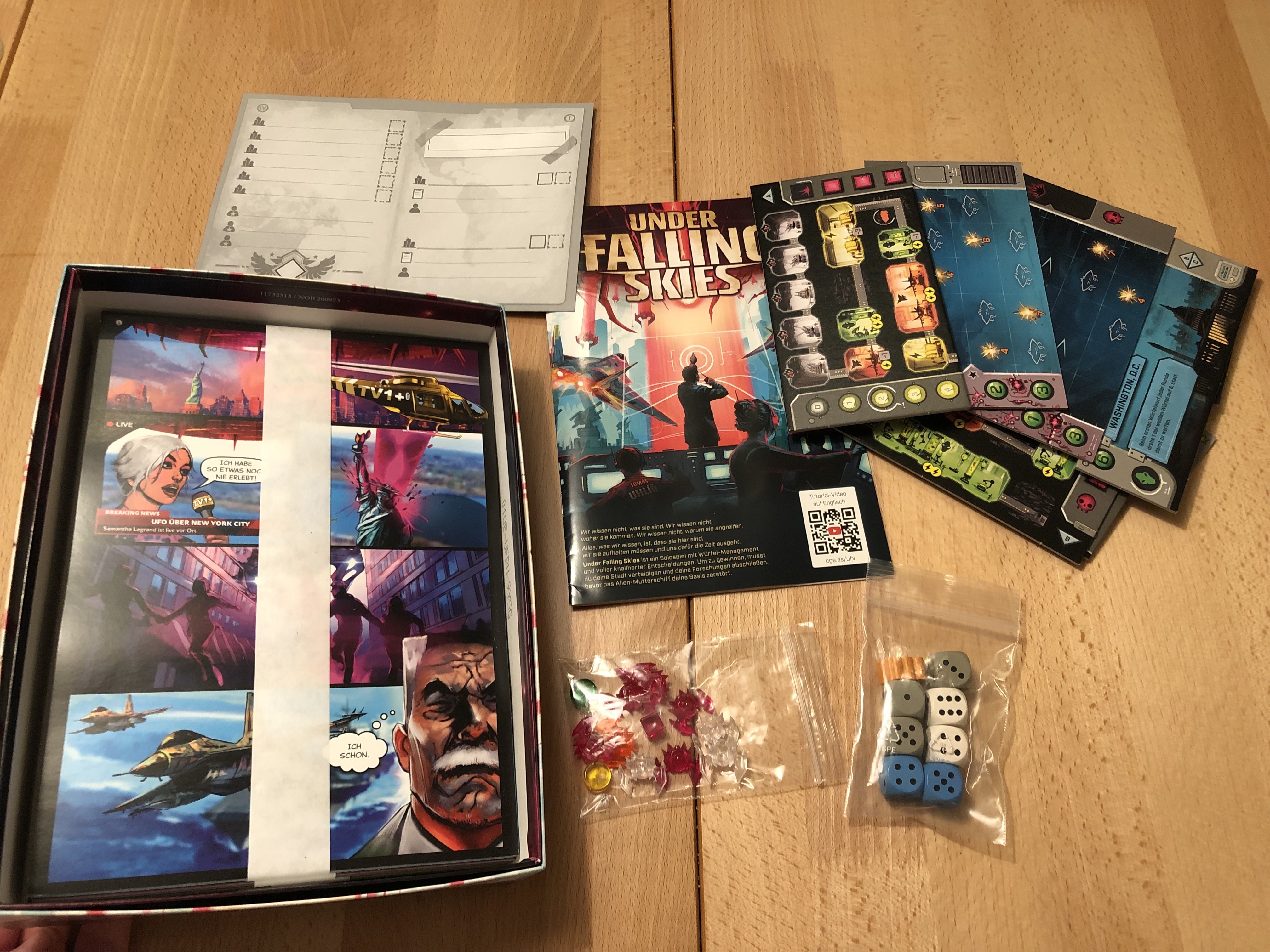
The box comes in a thoughtfully packed way. All the materials you need for the first few games are at the top, and the things deeper down in the box are neatly wrapped in paper bands so that you don't open them yet. Indeed, these are chapters in the campaign mode, which are unlocked one by one. I haven't played campaigns yet, just the always playable standalone game, and it's fun enough already.
In this game, things are, as hinted at, way more strategic than in the old shooter. Yes, the alien spaceships descend (and so does their mothership), and you have to shoot 'em up, but you also can build out your defence base, and add new capabilities like deployable fighters, energy sources, and research facilities. For that, you have a tunnel boring machine. And you have to be very strategic about how you deploy your resources; it's important to strike a good balance.
The aliens inflict enough damage, or the mothership descends to a certain low level above ground? The aliens win. You learn enough about them in your research facilities whilst fending them off? You win.
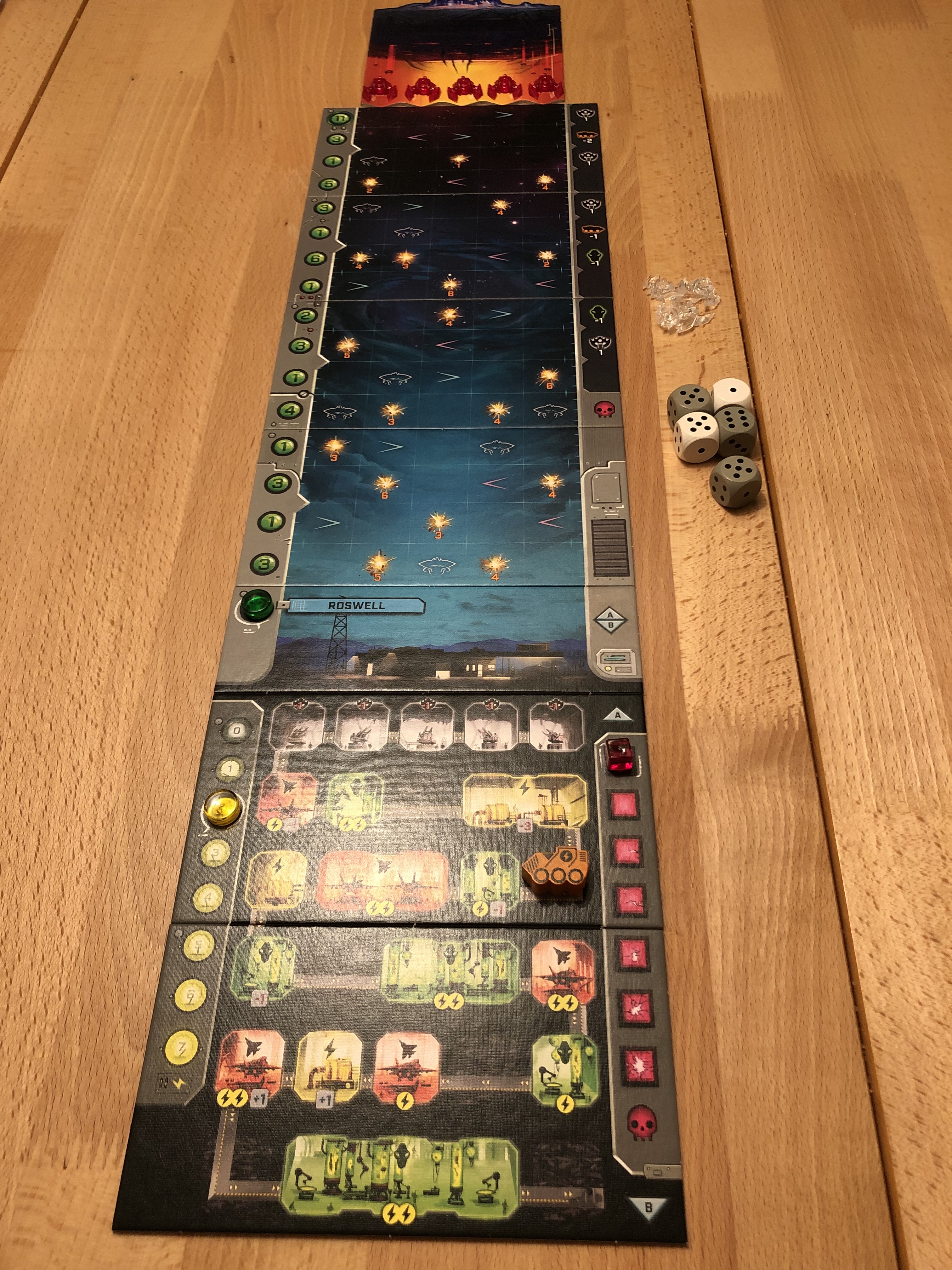
The start configuration has the base at the bottom, then the skies above, and the mothership at the top. There are five alien spaceships ready to be launched from the mothership. The tunnel boring machine is ready to advance to greater depths and enable new facilities in the base.
The dice are important: they control everything. You begin your round by rolling them. Then, you place one die in each column of your base, at any of the levels that the boring machine has left behind. With that, you activate the respective resources for this round. The downside is that placing a die in a column will also make the alien spaceship in that column descend as many rows as the die indicates. See how this gets interesting? There's one more caveat: once you've placed a white die, you have to re-roll all dice not yet placed. That also adds some spice.
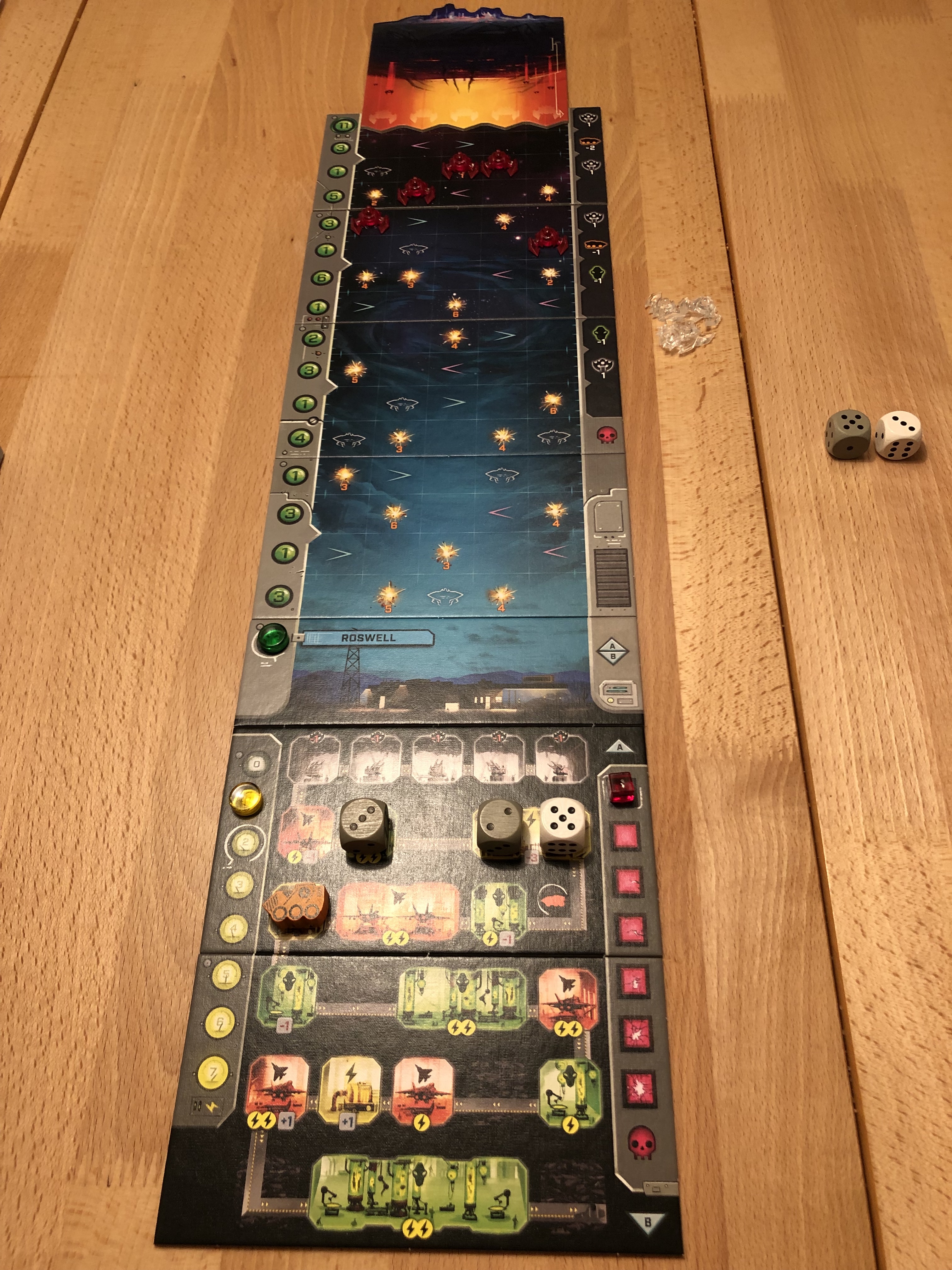
Here's the board mid-move: some of the alien spacecraft have begun their descent. If they reach the ground, they inflict damage and then return to the mothership.
At the end of your round, it's the aliens' turn. The mothership descends by one row - yes, there is time pressure! - and triggers some action. This could, for instance, make the tunnel boring machine revert some moves, which takes resources away from the base.
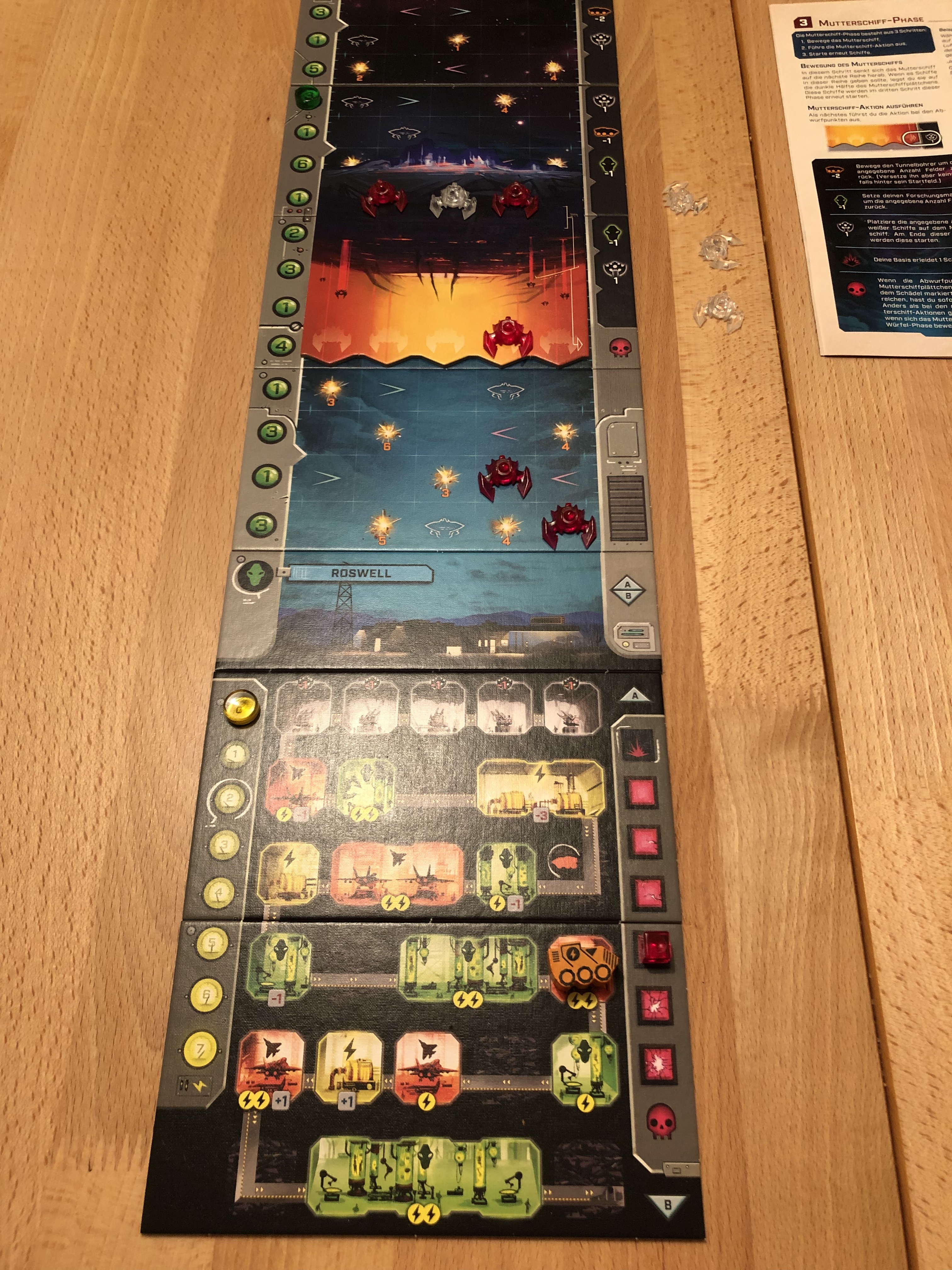
Of course, I lost my first game: the mothership reached the row with the red skull. Game over. I didn't pay attention to the actions the alien spaceships take when descending. The field they end their descent on may trigger an action: move to the left, move to the right, be attackable - and, yes, descend mothership by one row. That didn't help. You see how placing the dice carefully and strategically is really important.
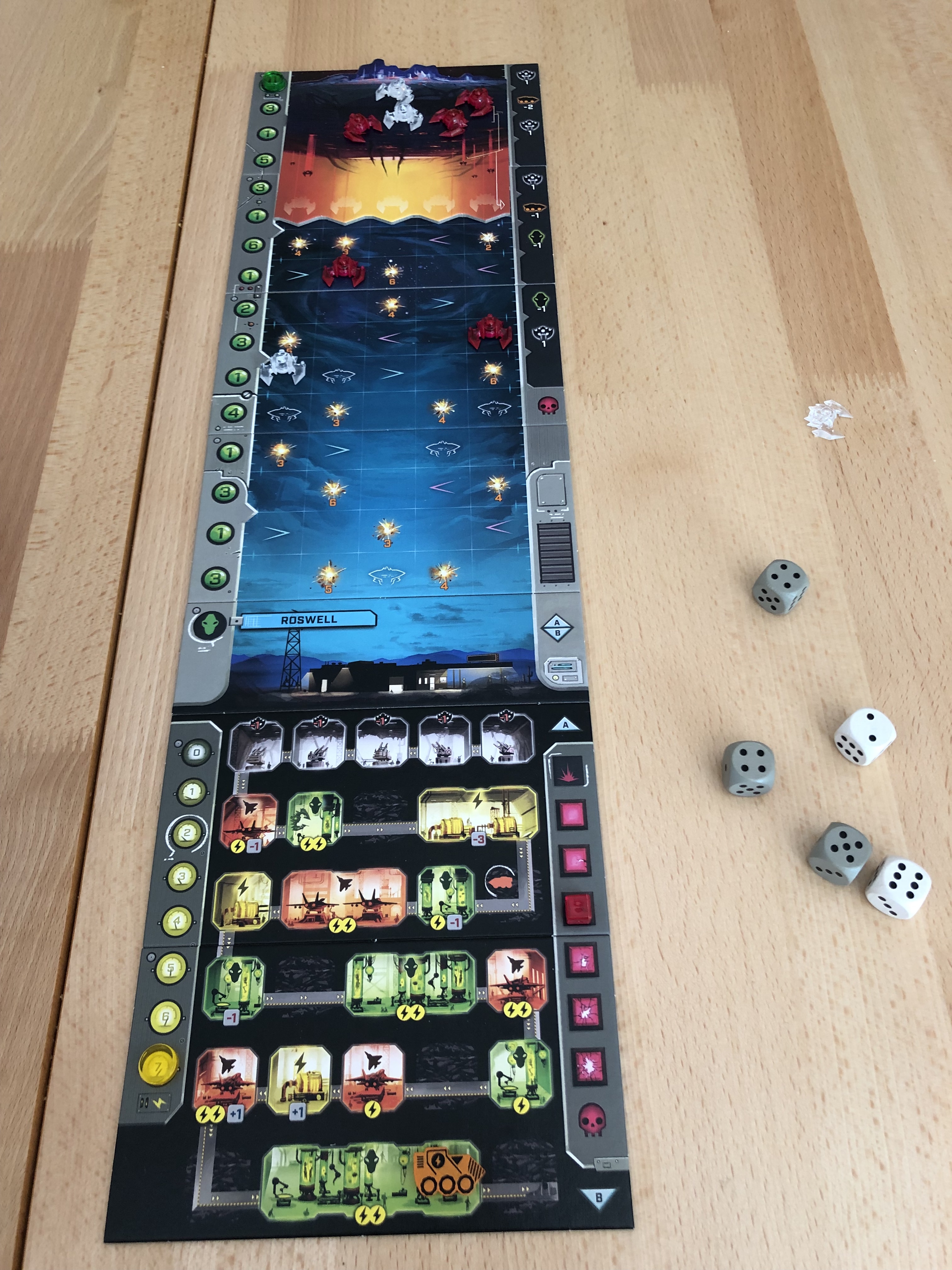
I won the second game. The green research marker on the left-hand side of the board has reached the top. Game over - for the aliens. Note how they haven't inflicted too much damage either (the red marker on the bottom right-hand side).
In summary, this is a very well done solo game, entertaining and difficult. Note that it comes in two difficulty levels, and I played the easier one. The campaigns should be fun. High recommendation.
Tags: games
Gloomhaven
A while back, I finally played my first round of Gloomhaven. My son, one of his buddies, and myself have decided to go through this together, and have founded a game group - we'll meet more or less regularly to play the game in campaign mode. Given the game's complexity and sheer size of the storyboard, we should be done when the boys enter their twenties in 6 years.
Gloomhaven is massive. The box weighs 10 kg, there's a vast amount of material. The rule book is 50 pages, complex but not complicated, well structured and presented, and we'll consult it frequently for the time being. The scenario book is equally well done, and the 95 different scenarios should keep us entertained for a while (see above). What's nice is that certain character classes and other materials in the box are currently still sealed and will only become available once we'll have made certain achievements.
Characters don't die, but they retire once they've fulfilled a "life goal", and then a new character has to be created who might change the dynamics quite a bit - a nice concept.
First, we built our characters. I ended up playing a tinkerer; my son, a spellweaver; and his buddy, a plain ol' barbarian (muscle is needed).
We then set out to make our way from the valiant city of Gloomhaven to the first scenario. What's cool about the game is that, in campaign mode, being in the city and on the road are part of the adventure. In the city, we bought some equipment, and saved one person from being hanged by the mob. On the road, we encountered a band of barbarian waylayers and foolishly decided to brawl with them. That didn't end well - we arrived at the first scenario with "reduced health". Too bad.
Our stupidity "paid off": my character didn't even get to making his first move before being incapacitated by the first wave of monsters. The boys stood their ground, defeated said monsters and then some, but eventually didn't succeed in finishing the scenario. We continued to play the next day, making our way back to the city to hopefully improve our general well-being. We eventually succeeded at the first scenario after lowering the difficulty level (general advice: that's a good idea especially for the first scenario).
Some final words about the game mechanics. It's very well done. Some games of this sort require one player to represent the monsters. Not so here; the monsters are fully programmed, their movements, how they focus on the player characters, and aggression follow a certain algorithm that's all written down in the rules and gets some variation from activity cards. What's also nice is the dynamics of each round: there is no fixed order in which characters and monsters make their moves; this is determined at the beginning of each round, also by drawing cards from the action deck.
After some more rounds and scenarios with the game, I'm very happy we finally got started, and pleased with how the game feels. This is going to be fun.
Tags: games
Tabletop Coffee Roasting
Board game time!
I'm enough of a coffee nerd to do my own roasting at home. Consequently, when I learned about the solo board game Coffee Roaster, it was entirely predictable and obvious what would happen. I've now finally played it for the first time. I cannot spare you a bit of unboxing discovery. Sponsored by a cup of delicious (home roasted) Maragogype from Guatemala.


The box is full of goodness, the materials are designed with great attention to detail and love to attention. An info sheet about coffee and the instructions are included in both German and English. So do the two small cardboard envelopes with coffee cards - these are the ones that you pick for roasting. The box has a nice fitting inlay that has all the compartments pre-marked with what cardboard chips should go in on the bottom of the box. Lovely. There are chips for beans at different stages of roasting - green hard bean to grade 4 to burnt bean -, for faulty beans, smoke, humidity, aroma development, and taste optimisation.
One round of the game consists of two parts: roasting and cupping. The black sachet plays an important role in both. The coffee card (I picked a Brazilian variety) says what chips go into the sachet at the beginning of the roasting process (typically, humidity, hard green beans, some grade-0 beans, and aroma development).
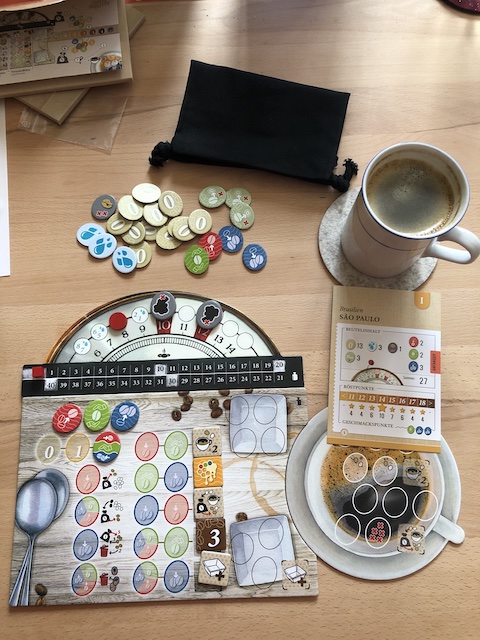
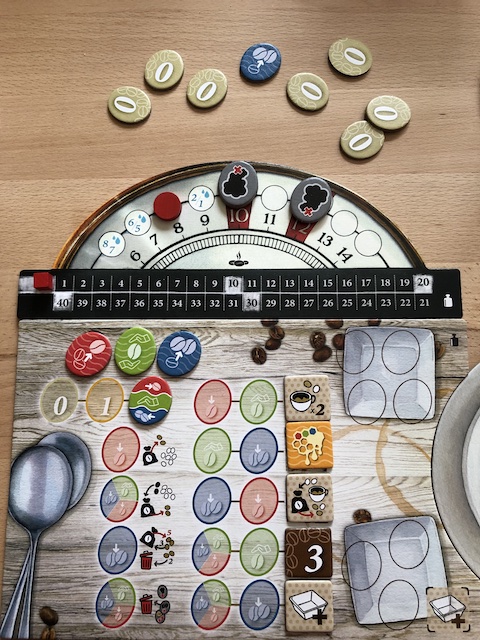
The round marker (the red round marker at the top) depicts how many chips I pull from the sachet - the very first move brought me some grade-0 beans and one aroma developer. The latter I can apply to do some spontaneous fixing operations (such as getting rid of burnt or faulty beans), or to acquire bonus taste developers for the cupping. The former are, well, roasted - this happens by replacing them with beans of a higher roasting grade. These go back into the sachet for the next roasting round.
As soon as the round marker hits the red area, smoke is added to the sachet (accurate: the more you roast, the more smoke there is), and care should be taken to not let that make it to the cup. The taste really isn't that good then.
It is the player's decision when the roasting should stop. The little red cube right above the main roasting table is used to track the overall roasting grade in the sachet - depending on what coffee you're roasting, it's good to stop the process sooner or later. Given the Brazilian beans I had picked for roasting, I decided to stop just before the round marker hit the second red field, which would have added more smoke.
On to cupping.
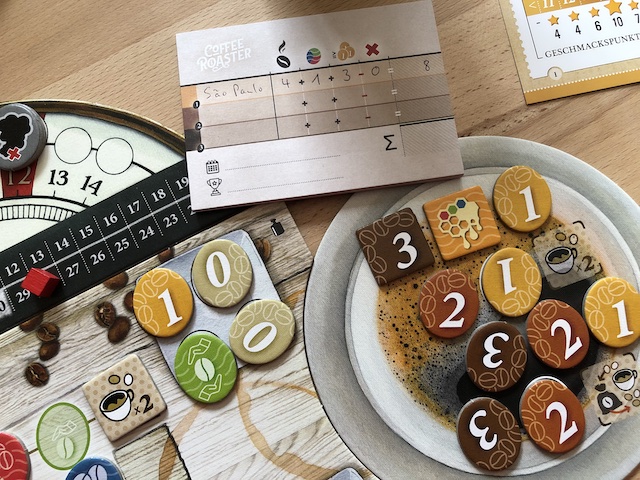
Cupping takes place by placing chips in the cup and then evaluating the outcome. You can see I acquired two taste bonuses (the square chips in the cup). Again, chips are pulled from the sachet and placed in the cup - or discarded by placing them in the "trash area" on the roasting table. There is a limited number of places both in the cup and in the trash, so the choices are important. If the trash is filled too early and a smoke chip lands in the cup, that's a minus point.
I scored 8 points in total here - mostly because I made some bad decisions. Purposefully, I didn't look at the rules too closely to learn from failure.
The score card shows I got 4 points for the roasting itself. The sum of roasting grades is 18, which is just barely acceptable. 14 would have been ideal - I'd have scored 10 points. I made the mistake of placing too many beans with higher roast grade in the cup. That makes sense - this kind of Brazilian bean doesn't like to be roasted too much, it's better for light roasts. I also got one point for taste development because I added the sweetness bonus. Finally, there's 3 points because I have a very balanced number of beans from each roast grade (1, 2, and 3). That adds up to 8. Not bad, but there's room for more!
The game is, all in all, a rather apt analogy of the roasting process as a board game. I was surprised by how accurately the process is modelled in the gameplay, and very pleased with how much fun it was to play it. Highest recommendation.
Tags: games
My City
Friends gave us My City for Christmas.
In brief, it's a placing game with cardboard pieces representing buildings in the shape of Tetris blocks. In each round, the players build their cities, and have to cover as much ground as possible. Some areas on the board can't be covered, some get you minus points if you cover them, some get you bonus points.
The game develops: in each round, the board can change by placing stickers on it that will stay there. The player is in charge of modifying their individual board, and the stickers will stay where they were placed, changing the game for the remainder of the, all in all, 24 rounds. Consequently, it gets ever more complicated.
This is a game for people who appreciate chewing on solutions for the knapsack problem, but without the backtracking option (once placed, a piece cannot be moved). I quite enjoy it, and so does our son - my wife and our daughter didn't like it just as much.
Tags: games
Terra Mystica
Terra Mystica is one of the most strategic games I've ever played - and it doesn't involve any slaughtering of enemies. It's actually a simulation of economy, settling, and societal development. The in-game currencies are money, work, faith, and magic; they can be converted into one another. The number of variables is immense, and the tangle of interdependencies is very complex.
Every player represents one people with unique skills, needs, and capacities. The witches can zoom around on their brooms, so they can establish new settlements easily wherever there's a forest. The desert nomads can control sandstorms, which they will use to terraform neighbouring landscapes into the kind of land they need to establish new settlements. All of these peoples are very well balanced against each other, so that it's up to the players to make the best of their game.
The game material is rich and very well designed. The complex rules and mechanics follow some pretty clear algorithms, which are explained everywhere on the board, cards, and other material using a kind of visual programming language. This makes it very easy to follow the rules without having to constantly check them in the rule book.
All in all, this game is probably not really for me - too much strategy perhaps. However, I need to give it some more chances before deciding that.
Tags: games
A Hobbit-Themed Card Game
Months back, a friend introduced me to the card game "Der Hobbit: Kampf um den Arkenstein". It's a clone of another game named "Love Letter" that I've never played, so everything I have to say is about the Hobbit variant. Since I enjoyed it quite a bit, I got myself a copy and played some rounds with the family, who warmed up to it quickly.
The game is simple. There's just a bunch of large and robust cards, a short rule book, and some wooden crowns my daughter chose to name "duck feet" for their shape. The game is about staying in the game or having the card with the highest value in the end once all cards have been played. Players can have only one card in hand, and drawing another means that one of the two must be dropped. Each card enabled a distinct move that can involve swapping cards with another player, taking a peek at another player's hand, making a player drop their card and draw a new one, and so forth. It's really quite simple, and the mechanics are explained on the cards in enough detail to get started in 5 minutes.
It's fun. Keeping track of what cards have been played is important - and not too hard because there are only 17 of them (and 8 different types, which exist in different quantities). The mechanics allow for some surprising moves and quick turnarounds in the gameplay.
I'd recommend it for just about any audience. :-) The Hobbit theme isn't necessary (although this variant of the Love Letter brand has one more card that makes for another surprising turn), so one of the other variants could work as well.
Tags: games
Root
Thanks to a dear former colleague at eBay, I've come to know some interesting board games, and Root is one of them. It's a competitive game, in which there are four factions that all want to gain hegemony over the forest they live in: cats, birds of prey, an alliance of smaller woodland animals, and the raccoon. The fun bit is that each faction has its own rules and mechanics. To give an example, the birds actually have a program of actions they run in every move, and instructions keep being added to it. As soon as just one of the instructions can't be executed - for instance, no new nest can be built because there's no available space in the forest that the birds control - their leadership is overthrown, points are lost, and the program needs to be started from scratch. I love the crazy dynamics this game can develop.
Tags: games